There are many different types of daisies available, and you can choose the type that best suits your garden. Sunflowers, for instance, are a great choice for the informal garden, as they grow only one to three feet tall. Sunflowers like moist, well-drained soil that has a neutral or slightly acidic pH. In addition to being hardy in USDA zones 9 through 11, they can tolerate a variety of climates and soil conditions.
There are over 20,000 different species of daisies, including those that are small and showy. However, there are some common types of daisy that have widespread popularity, including African, gerbera, and Shasta and Bellis daisies. The most popular types of daisies are the African, Marguerite, and gloriosa daisies.
What Is A Daisy?
A daisy is a plant in the family Asteraceae, commonly referred to as a common, English, or lawn daisy. Bellis perennis is one species in the family that is often considered the archetype of the daisy. There are many varieties of daisies, such as the English daisy, which is the most common. Here is a look at some of these popular types of daisies and what they do for our gardens.
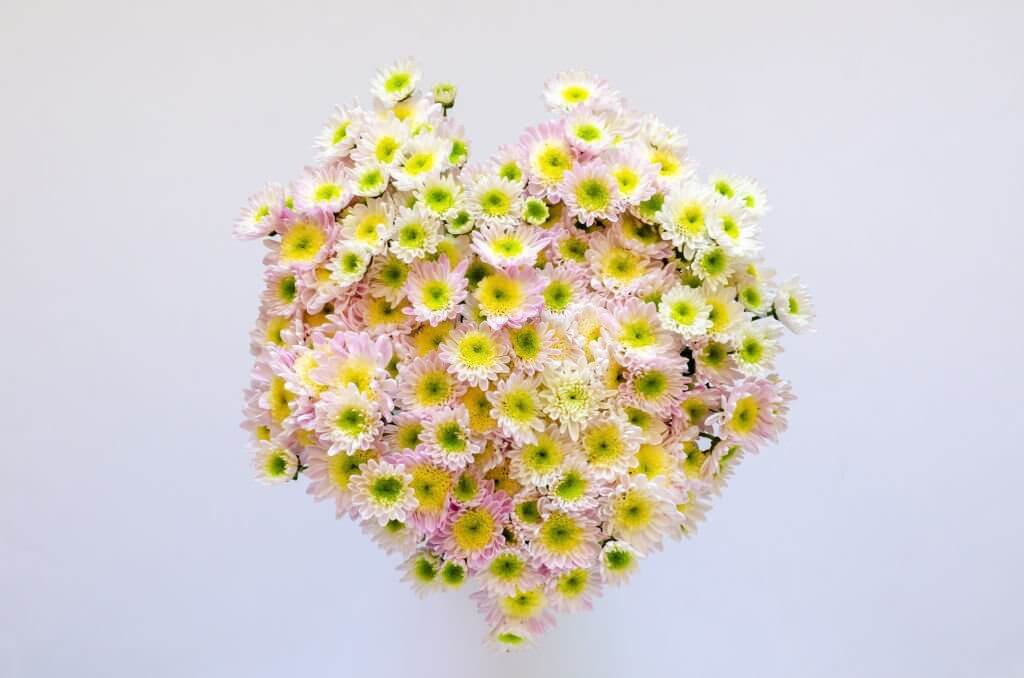
Daisies are easy to draw and grow in a wide range of conditions. Their name means “eye of the day” because of their central disk and surrounding petals. They are also hardy to USDA zones seven through ten. Daisies also tolerate a wide range of soil pH levels and are best grown in well-drained, moist soil that is acidic or alkaline. They are an excellent choice for informal gardens.
How To Identify Daisies?
One of the most cheerful plants in nature, daisies are native to all continents except Antarctica and thrive in most parts of the U.S. Aside from being cultivated by gardeners in flowerbeds, they also grow wild in many places. Although daisies have no leaves, they are known for their star-shaped heads and discs of florets made of black or yellow material. In fact, daisies are not actually flowers at all but instead are composed of many smaller florets.

The name “daisy” comes from an Old English phrase that means “day’s eye.” The flower’s petals close at night and reopen in the morning, giving the flower a distinctive star-shaped shape. In addition to their star-like appearance, daisies can have single rows of petals, or double rows. They are often associated with Mother Mary in Christian belief and are one of her most sacred flowers.
Are Daisies Annuals Or Perennials?
Although daisies are perennials, they are easy to damage by aphids, slugs, earwigs, and other pests. The good news is that you can battle these pesky insects by planting companion plants, which will deter these pests and encourage flowering again. You can also deadhead the flowers to prevent mold growth. Daisies need healthy soil with a pH of 6.0-8.0.
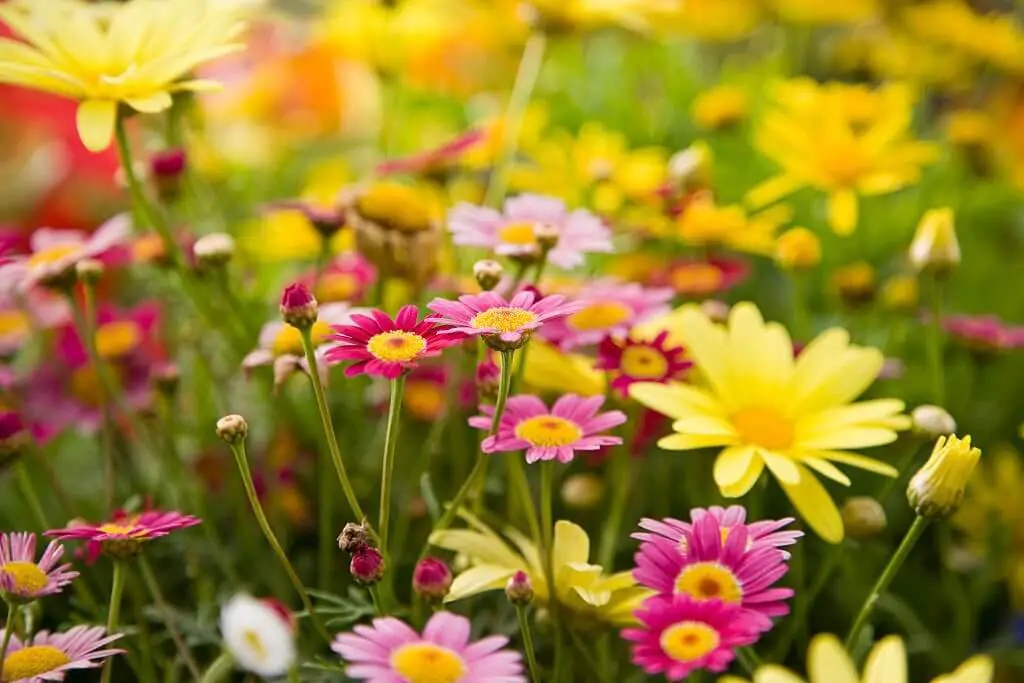
Daisy plants come in two basic types: annuals and perennials. Annual daisies bloom in spring and fall, while perennial daisies grow year-round. If you’re wondering which to buy, consider this: daisies are native to North America and grow in a variety of climates. These plants grow from pink buds and bloom in the summer and fall. You can scatter the seeds from these flowers in the fall to create a drift of flowers in the spring. Perennial daisies will return to your garden year after year for a show of color.
Family: Asteraceae
The family Asteraceae is part of the order Asterales, which contains 32,000 species of flowering plants. It is commonly known as the aster family, and the first members of the family were described in 1740. This is an extremely diverse family, and there are many different types of asters. You may also recognize it by its scientific name, Compositae. Despite this diversity, it is a relatively unknown family.
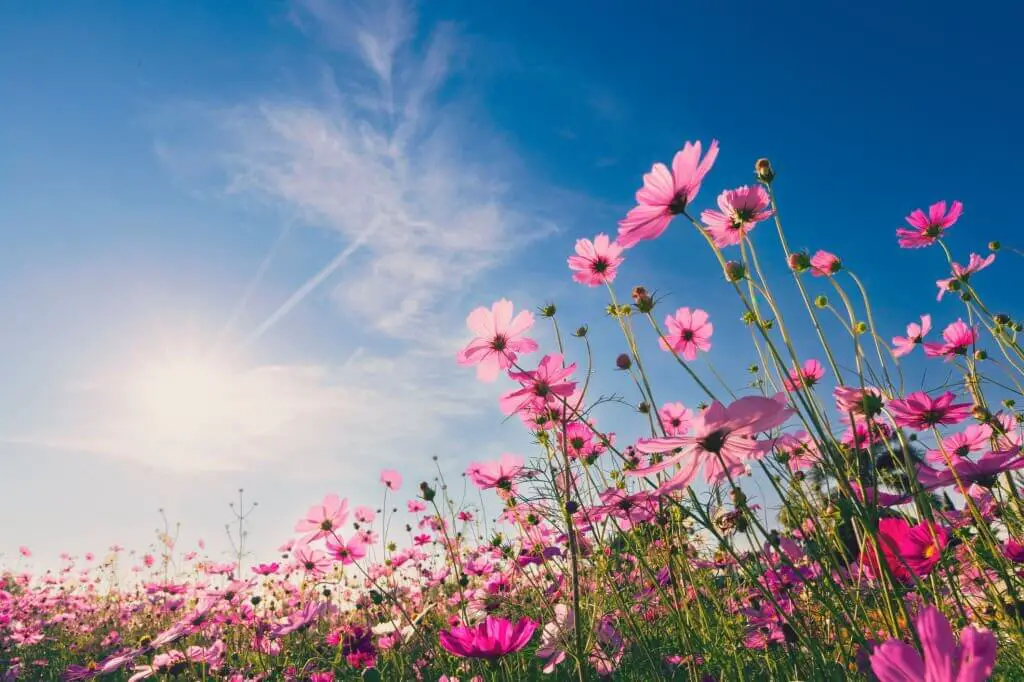
The flowering stems of Asteraceae are usually composed of composite flower heads called capitula. The involucral bracts on the capitula are similar to the petals of other flowers. Although they appear separate flowers from a distance, the outer parts of the capitula are actually two flowers.
Subfamily: Asteroideae
The plant family Asteraceae contains fewer than 100 species. With fewer than 100 species, the Asteraceae is a good choice for comparing biodiversity between closely related groups and is especially useful for evaluating past climatic changes and morphological innovations. To better understand how the Asteraceae has evolved and why some species are more diverse than others, here are some details of their evolutionary history.
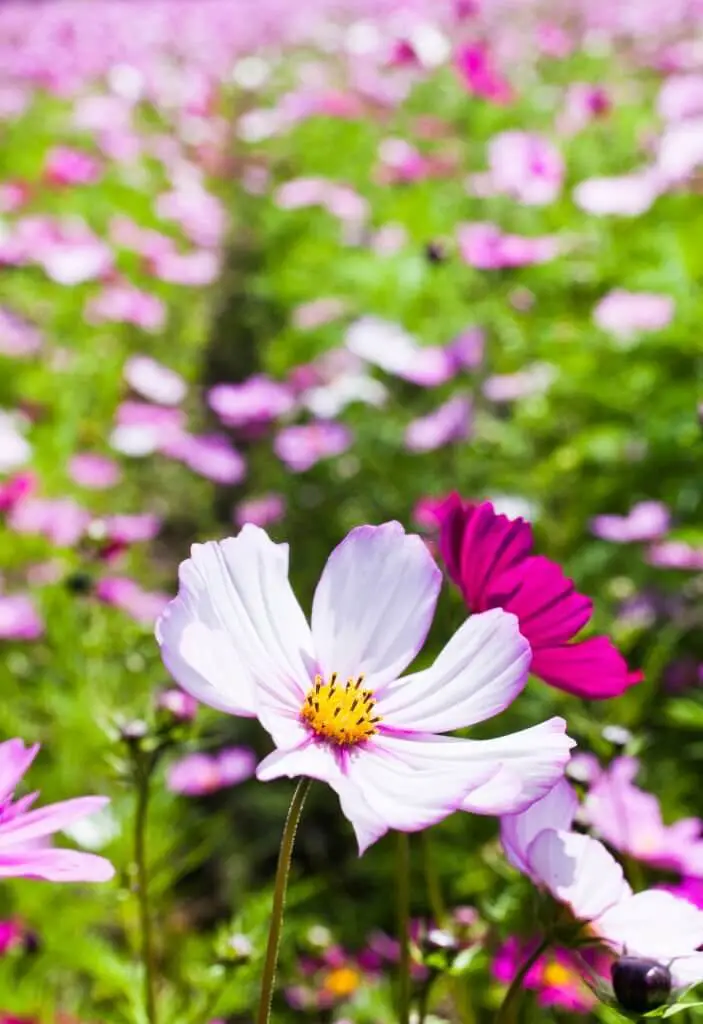
The Asteraceae is comprised of two major subfamilies, the Asteraceae and the Cichorioideae. Together, these subfamilies comprise 41 of the 45 recognized tribes of Asteraceae. These two subfamilies are sister groups. The Heliantheae subfamily consists of sunflowers, Tageteae, and Coreopsideae. These are all members of the family, and are the most common.
Asteraceae Morphology: The Asteraceae possesses a distinctive head inflorescence composed of sessile florets. They may be solitary or a component of an inflorescence of a higher order. The florets in the capitulum may be bisexual, homogamous, or heterogamous. The morphology of the corolla is important as the florets differ in morphology. Some subfamilies feature actinomorphic disc florets, while others display zygomorphic ligulate florets.
Tribe: Astereae
The fossil record of the Tribe of daisies is relatively incomplete, so we conducted a phylogenetic analysis of all plastid-derived genes. Using rRNA regions as trees of genes, we tested the relationship between Tribes Astereae and Anthemideae by calculating the distance between their plastid-derived gene families. The analysis revealed that these two lineages are sister taxa, with their most recent common ancestor in the Fab Five Clade. Phyluce was used because it has higher confidence in its phylogeny than HybPiper, and it generates more accurate plastid-derived gene trees.
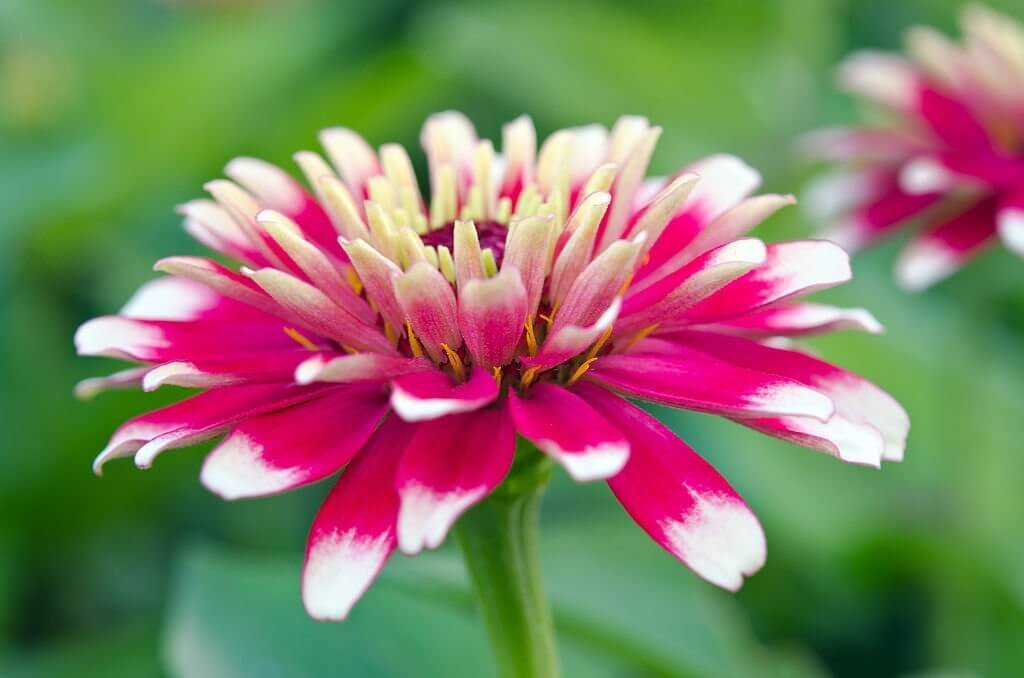
The Asteraceae subfamily is the most diverse plant family in the world, with more than 15,000 species across 13 genera and two supertribes. The Arctotideae subtribe comprises four genera and 64 species, with an estimated total of 1800. The phylogenetic analysis of these three subtribes identified 212 species and two major clades. Phylogenetic analysis of the Asteraceae subfamily reveals that they are monophyletic, and have a diverse range of morphological characteristics.
Types Of Daisies From The Genus Arctotis
When it comes to daisies, the Genus Arctotis has no less than four subspecies: Bellis, Hirsute, Stoechadifolia, and more. These species differ in the appearance of their flowers. However, all are hardy to USDA zones seven through ten. As a result, they are often used in gardens, even in containers.
1. Arctotis Fastuosa
Originally from Africa, Arctotis Fastuos is a plant native to southern California and Namibia. While native to their home country, they have since become naturalized in California. However, this does not mean that you can’t enjoy them as a landscape plant.The species is easy to identify if you see them. In addition to its colorful foliage, they also produce a bitter taste.
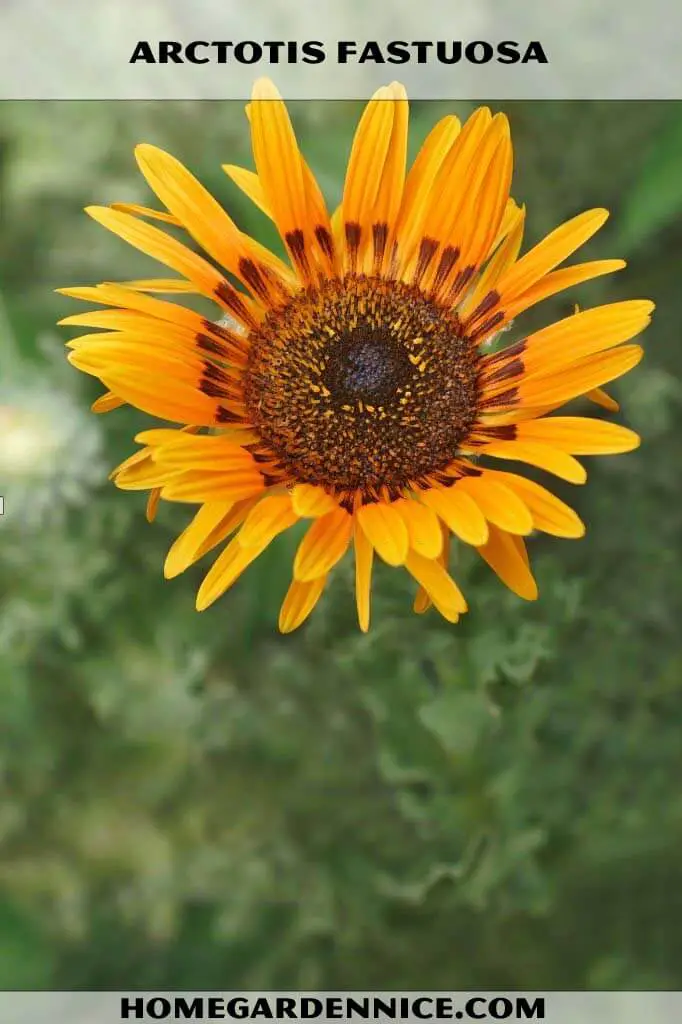
The seeds of Arctotis Fastuos are tiny, and look like grape pips. They ripen in old flower heads about a month after flowering. Seeds of Arctotis Fastuosa are not poisonous and can be planted in early spring. They require full sunlight and do not need pretreatment to survive. You can grow this plant year-round, even in coastal areas.
| Light | They Need Full Sun |
| Hardiness | USDA Zone 11 |
| Height | 600 mm |
| Soil Requirements | Acid, Neutral Sandy Or Loamy Soil |
| Flower Color | Cream, Yellow, Orange |
2. Arctotis Hirsuta
The endemic South African lizard Arctotis hirsuta is found primarily in the Western and Northern Cape. It prefers sandy slopes and flats on the coastline, typically between the Agulhas Plain and Elandsbaai. While it is not a pest, hares can be a nuisance in a residential area. To avoid these pests, the first step is to learn more about this lizard.
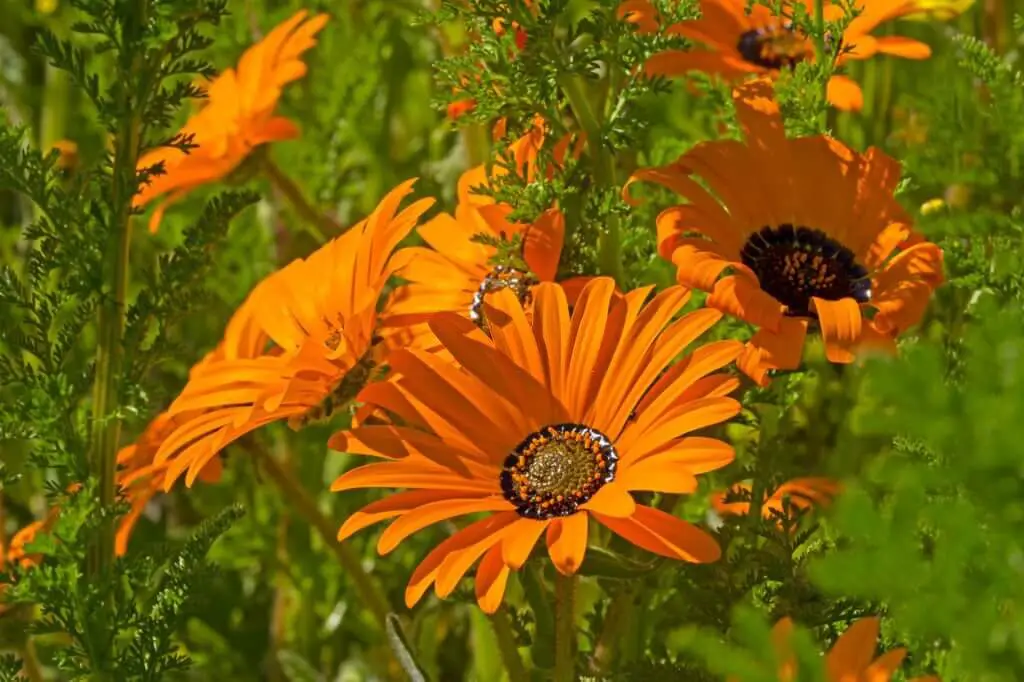
The genus Arctotis consists of sixty species and is native to southern Africa. These types of daisies genus extends southward into southern tropical Africa, including Angola. The genus Arctotis acaulis, commonly called the African daisy, is native to the western and northern Cape. It is a perennial, hardy plant that grows on low, gravelly soil.
| Light | Full Sun |
| Hardiness | USDA Zone 8 |
| Height | 450mm |
| Soil requirements | Sandy, Clay, And Loamy |
| PH | Neutral |
| Flower color | Cream, Orange |
3. Arctotis Stoechadifolia
This stunning groundcover plant is easy to grow and looks magnificent in spring gardens. It has many types of growth, including tufted annuals, trailing perennials, sprawling shrublets and semi-woody shrubs. It is especially useful in coastal gardens and dune areas. These types of daisies can survive dry summers and winters and resprouth vigorously. The most common types are white and blue-flowering.
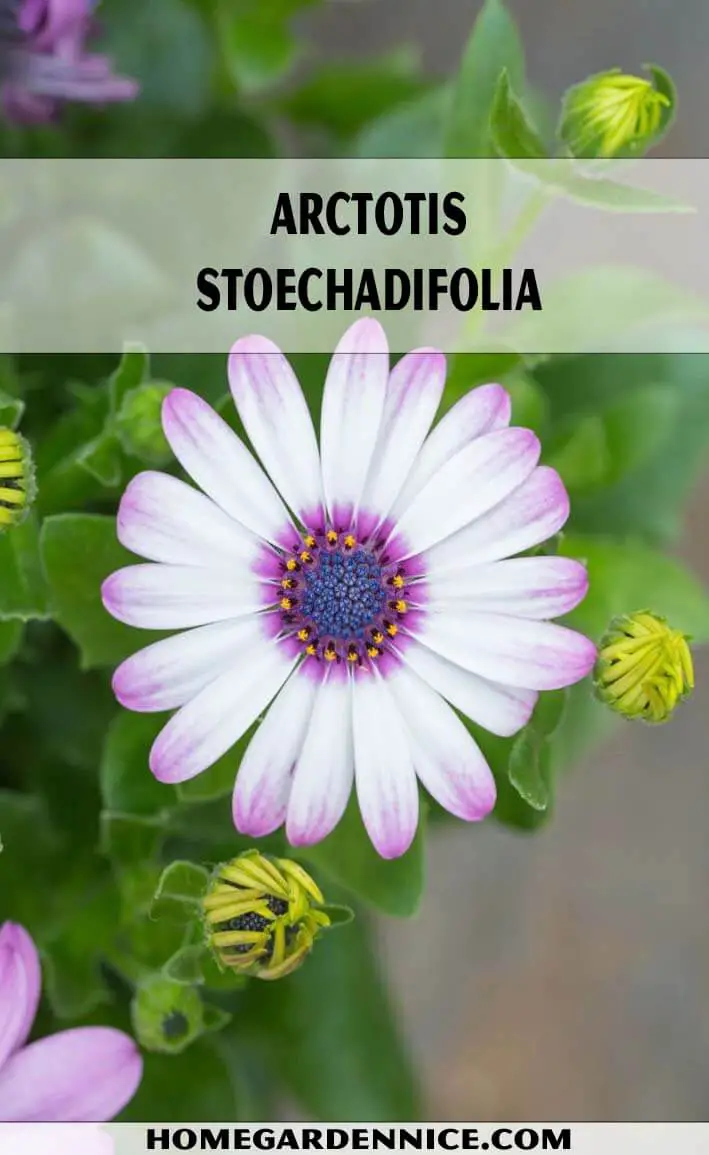
The flower head consists of central clusters of dark disc florets with stamens and stigmas. The ray florets are different in colour from white to cream to red and mauve. They release an acrid smell when bruised. The flowers only open in bright sunlight and remain closed in cold weather. In the wild, this plant is not very attractive but does well in gardens.
- Light: Full Sun
- Hardiness: USDA Zone 9
- Height: 350mm
- Soil requirements: Sandy
- PH: Acid, Neutral
- Flower color: Cream, Yellow
4. Arctotis Grandis
Located in the west coast of Cape Province, South Africa, the plant is called arctotis grandis, African daisy, or white arctotis. This solitary plant grows only in sand dunes. Among other names, these flowers are known as white arctotis. Here is a look at these stunning flowers.
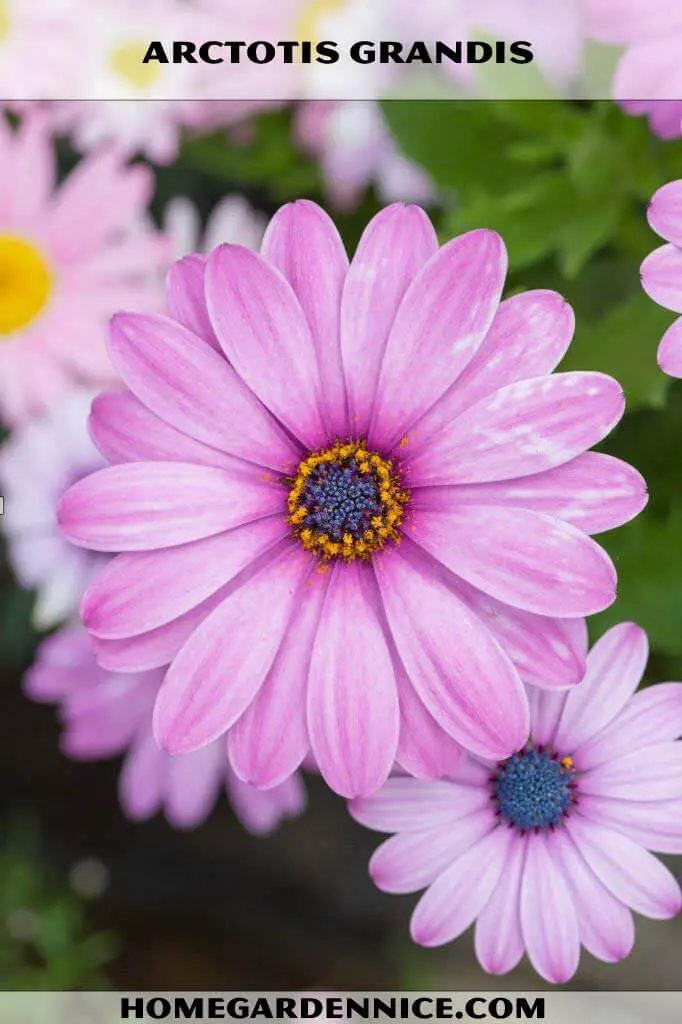
The foliage of Arctotis Grandis is grayish-green, and the flowers are white or pale violet. They are easy to grow from seed and are easy to propagate. These types of daisies do well in a light mixture of peat and sand. They can be planted in the fall. Keep the soil temperature around 45 degrees F so that they will not become too hot. Arctotis Grandis is a great plant for rock gardens and container planting.
- Light: Full Sun
- Hardiness: USDA Zone 9- 11
- Height: 60cm
- Soil requirements: well drained light soil
- PH: Acidic, Neutral
- Flower color: White Or Pale Violet
5. Arctotis Acaulis
The flowering plant Arctotis acaulis belongs to the family Asteraceae. It is an endemic species, found only in the Cape Provinces of South Africa. In the wild, it can grow to be about two feet tall. The species is used in both landscaping and food preparation. It is a popular ornamental plant and is widely known for its vivid colors and fern-like foliage.
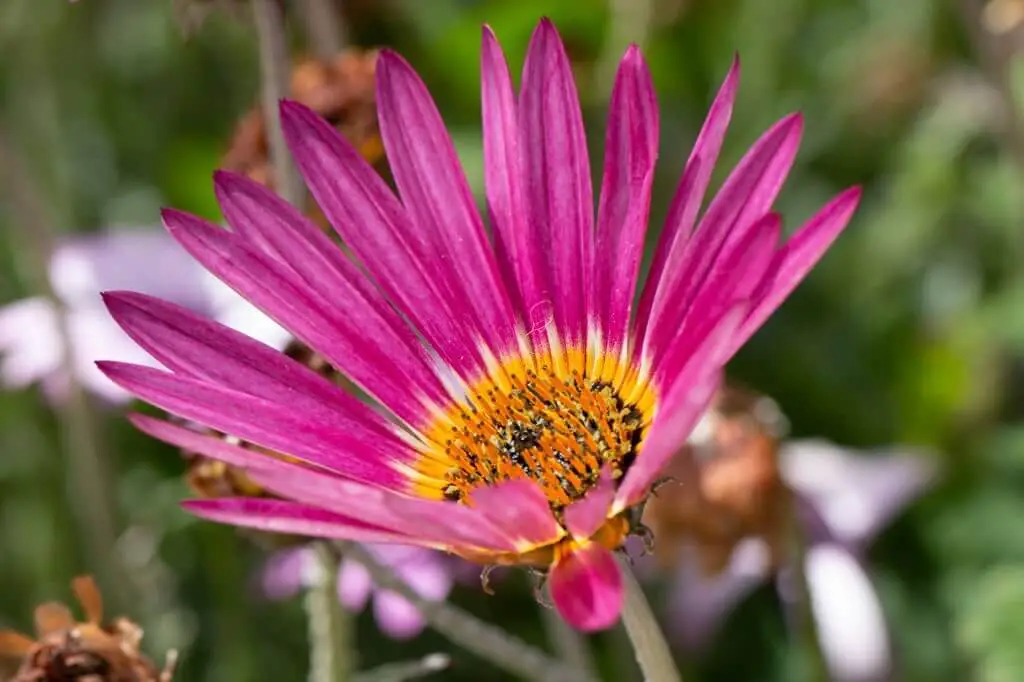
The genus Arctotis consists of 70 to 99 species and is native to the Mediterranean and temperate zones. Depending on climate and soil conditions, different species have different flowering times, and the time of year they bloom can depend on their growing conditions. In addition to its beauty, Arctotis is easy to grow and maintain. However, for best results, treat the plant like an annual, and prune the flower heads after a year.
- Light: full sun
- Hardiness: USDA Zone 9
- Height: 30cm
- Soil requirements: sandy, clay loamy
- PH: Acid, Alkaline, Neutral
- Flower color: Pink, Cream, Yellow, Orange
Types Of Daisies In The Genus Bellis
There are several different types of daisies in the Genus Bellis. The common daisy, Blue Eyed Daisy, Robella, and Monstrosa are just a few. Let’s dive into the details of these flowers. Then you can decide which one is best for your garden! We hope this information has been useful for you!
6. Red Bellis
The compact, low-growing plant has large, pompon-like flowers that appear in the spring and autumn. It is perfect for planting in containers, window boxes, and front borders. It is easy to grow from seed and is highly attractive to bees and butterflies. Red Bellis is the most common cultivar. It is also a popular cut flower. Its flowers are best enjoyed in partial shade. This is a beautiful perennial for your garden.
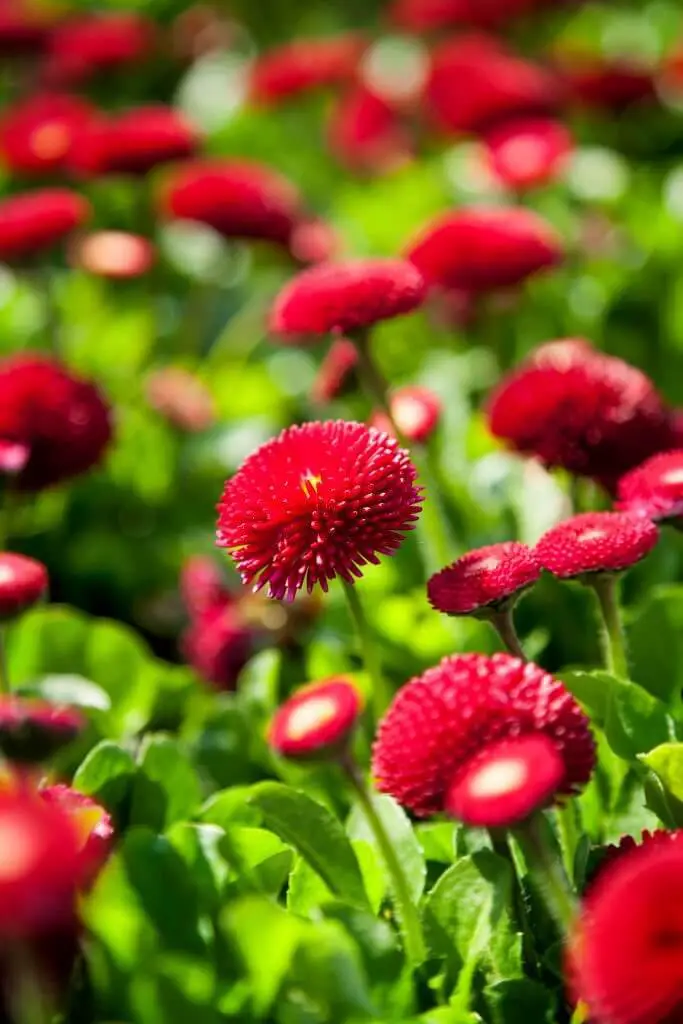
The bellis genus is found in Europe. It is widely grown wild in the continent. This perennial is a common sight on the coasts of the United States and in English lawns. Its new hybrid varieties feature larger flowers and are easier to care for than its wild counterparts. The plants are low-growing and grow from a rosette. The flower color is light pink and the foliage is green. They have long, thin stems and a low-growing habit.
Light: Full Sun
Hardiness: USDA Zone 4-8
Height: 15cm-20cm
Soil requirements: Sandy or Clay
PH: Neutral, Alkaline, or Acid
Flower color: Red
7. Blue Eyed Daisy
Planting a Blue Eyed Daisy is very easy and requires minimal maintenance. They like bright, sunny days with cool nights. They also prefer rich, moist soil. For the best results, space your plants at least nine inches apart. You can use light fertilizers to help them thrive. The first time you plant a Blue Eyed Daisy, be sure to rake up any clumps of grass. Once the first flower appears, wait at least one month before fertilizing.
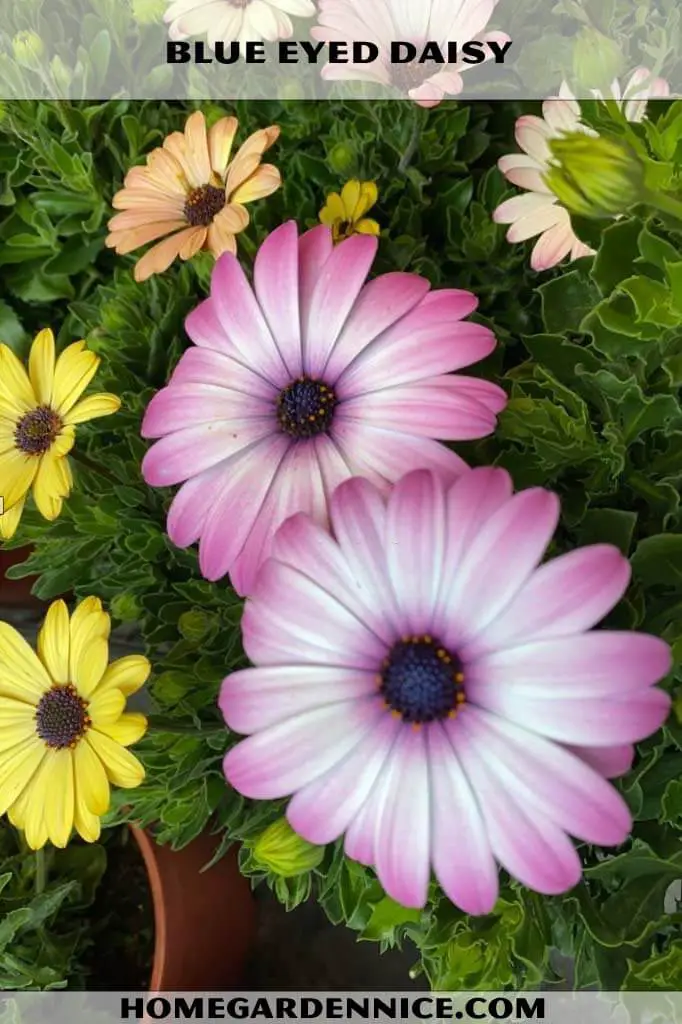
The Blue Eyed Daisy has more than 50 flavors of cupcakes to choose from. It is a favorite in many parts of the world. The colorful flowers have many names, including blue-eyed African daisy, arctotis stoechadifolia, acacia, and lupine. It is not poisonous to humans, though; it only causes respiratory paralysis. Because it’s not native to North America, it can grow in gardens and urban areas.
- Light: Full sun
- Hardiness: USDA Hardiness Zone 3-11
- Height: 25cm-40cm
- Soil requirements: loamy soil
- PH: Acidic
- Flower color: Butter Yellow, Violet
8. Bellis Robella Daisy
The ‘Robella’ variety of daisies is a Gold Medal winner from the European Fleuroselect. The inflorescences of this variety are densely double and are red or pink and grow only a few centimeters long. The flowers bloom from March to June. They are small, five to six centimeters in diameter, and the stems are semi-evergreen, with green foliage. Robella daisies are sometimes mistaken for bella daisies, which are more compact.
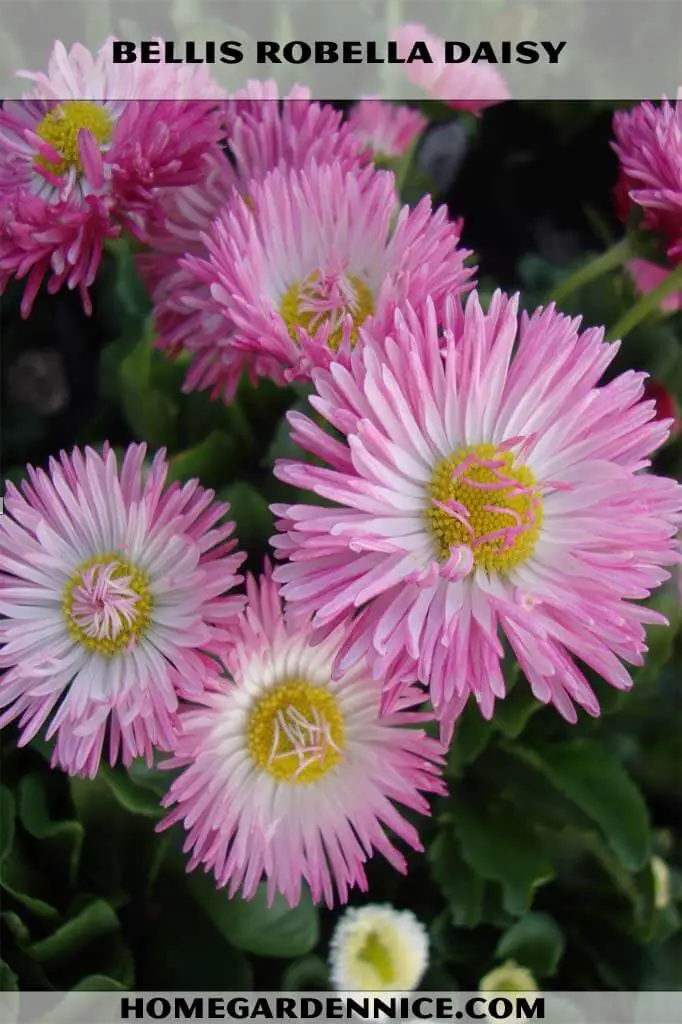
The second year of a daisy’s life begins with a top dressing, applied in early spring. This fertilizer is applied in standardized proportions for each plant. The daisy needs more fertilizer during flowering and throughout the second year of growth. If you are growing a large plant, you can divide it into four to six separate plants. For best results, divide your daisy bush every two to three weeks.
- Light: Full Sun, Partial Shade
- Hardiness: USDA Zone 3-9
- Height: 10-15 cm
- Soil requirements: Normal, Sandy, Clay
- PH: Neutral, Alkaline, Acid
- Flower color: Deep Pink, Salmon
9. Bellis Perennis Monstrosa
The bellis perennis monstrosa, also known as the’monster daisy,’ is a large-flowered variety of Daisy. Its flowers are rosy red and pink and grow on leafless stems that dangle from a spreading mat of semi-evergreen foliage. This annual flower is typically planted in early spring, and it blooms for two or more years.
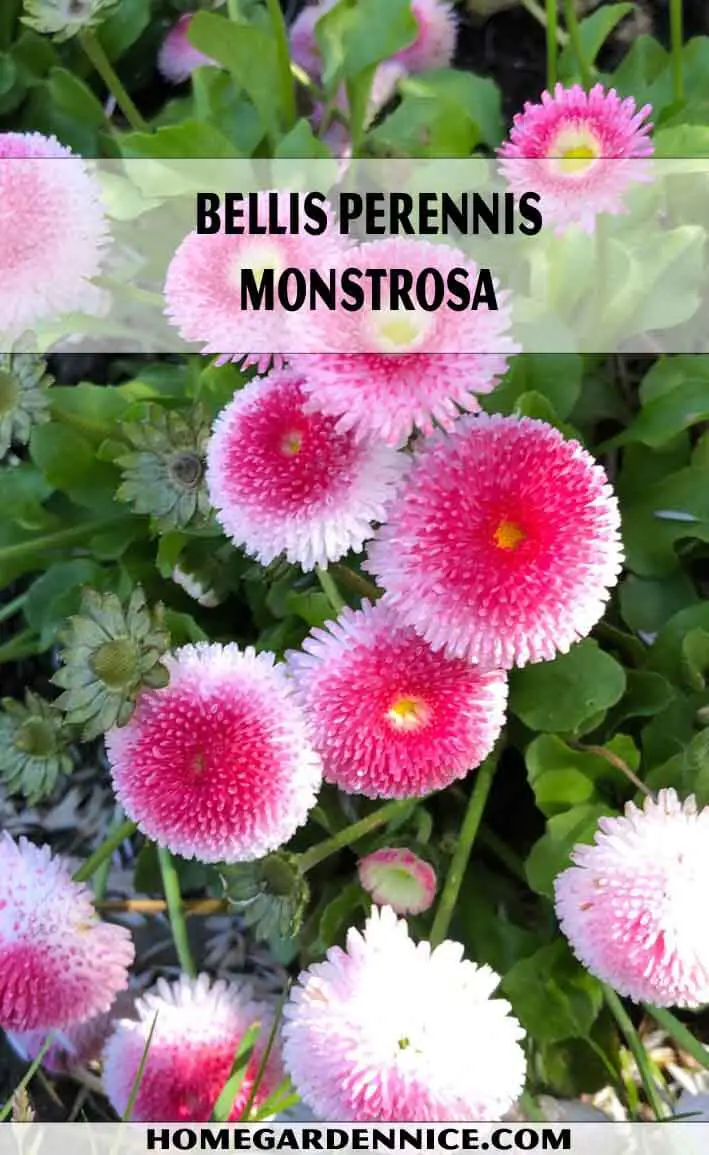
- Light: Full Sun, Partial Shade
- Hardiness: USDA Zone 3-9
- Height: 10-15 cm
- Soil requirements: Normal, Sandy, Clay
- PH: Neutral, Alkaline, Acid
- Flower color: Deep Pink, Light Pink, Mixed, Red, White
10. Rob Roy Daisy
Despite its invasiveness, the Genus Bellis and Rob Roy daisies are delicious additions to the dinner table. Young leaves are delicious lightly steamed and tossed with butter and salt for a tangy salad. The flower buds can also be tucked into sandwiches. Like the tulips, the daisy flower has a unique lettuce flavor. If you are concerned about the plant’s astringent taste, you should know that the flower doesn’t contain any pesticides. And before you make the switch to a salad featuring daisies, make sure to try them in small amounts to gauge your tolerance level.
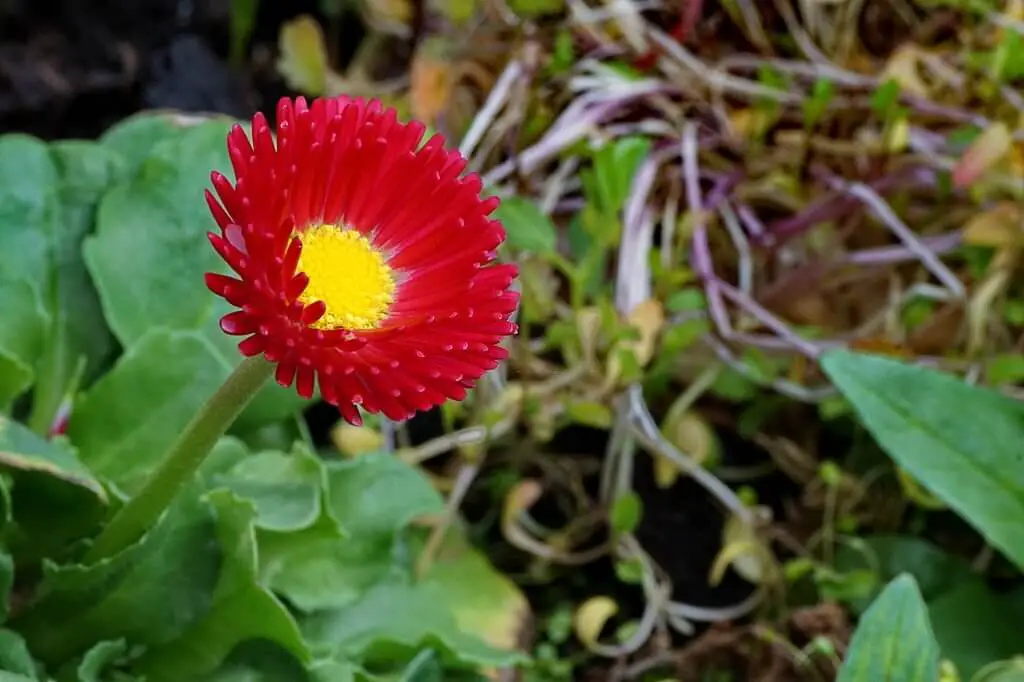
The ‘Rob Roy’ variety of Common daisies is a classic perennial cultivar with charming double crimson red flowers with a prominent yellow center. It grows to about 30 cm (11.8 inches) tall and will self-seed if allowed to. The plant is drought tolerant and thrives in both normal and damp soil. Rob Roy daisies grow best in a sunny area with regular water.
- Light: Full Sun, Partial Shade
- Hardiness: USDA Zone 4-11
- Height: up to 30cm
- Soil requirements: Average, Tolerates Poor, Well-drained Soil, Tolerates Sandy, Loamy Soil
- PH: Neutral
- Flower color: Red, Yellow
Types Of Daisies from the genus Monoptilon
There are several types of daisies, including the popular purple coneflower. They can be found in the Mississippi Valley and eastern North America, including much of New England. These types of daisies prefer full sun and consistent moisture. They are best grown in an area that receives at least some protection from extreme weather. Their tiny flowers are in the center, making them excellent for pollinators. Here are a few examples of these plants.
11. Monoptilon Bellioides
Often referred to as the Mojave desert star, the desert star Monoptilon bellioides is a member of the family Asteraceae. It grows in arid desert areas. Among its many names, the desert star is a favorite of stargazers. Here are some facts about this fascinating star.
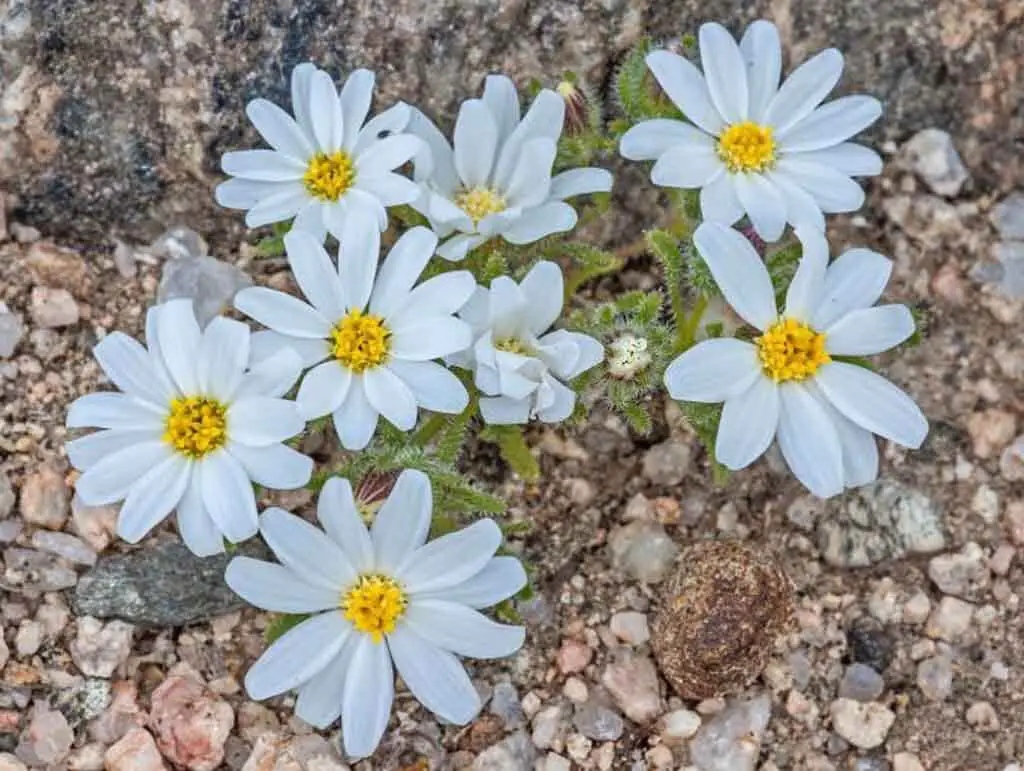
The desert-adapted Monoptilon Bellioides is native to the Mojave Desert of California, the Sonoran Desert of Arizona, and the Bajac Peninsula in Mexico. It grows up to six inches (15 cm) in height and can cover large areas of bare desert ground. Among its other traits, the desert-adapted flower attracts butterflies, hummingbirds, and other insects.
This desert-adapted flower is relatively small, but its ray florets are quite distinct. The petals of the flower are white with a yellow center. The stems are reddish in color. It blooms during the springtime in washes, and it is typically found in desert scrubs and desert areas. The habitats in which it grows include the Mojave National Preserve and Death Valley National Park.
- Light: Full Sun, Partial Shade
- Hardiness: USDA Zone 9-10
- Height: up to 25cm
- Soil requirements: sandy, gravelly, and rocky soils.
- PH: Alkaline
- Flower color: White and Yellow
12. Monoptilon Bellidiforme
Monoptilon Bellidiformi (monoptilon daisies) is a flowering plant in the family Asteraceae. It is commonly known as daisy desertstar. This flower is native to the desert southwest of the United States. It grows in typical desert habitats, including rocky cliffs, sand dunes, and open plains. However, it also thrives in other areas, including the Pacific Northwest and Canada.
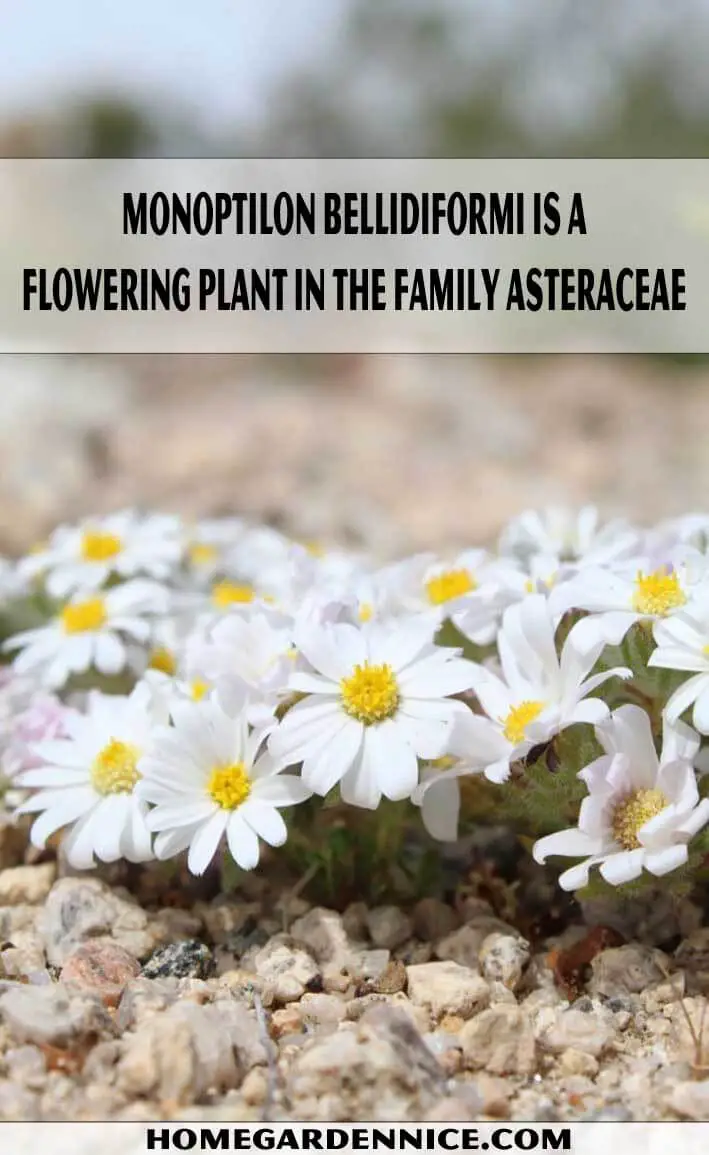
The flower head of Monoptilon bellidiforme is small – only a few centimeters long – and has many ray florets ranging from five to seven millimeters in length. Monoptilon bellidiforme’s leaves are small, no longer than a centimeter, and they have a blunt tip. Monoptilon bellidiforme can grow in dry, sandy environments, but it is not common in our area.
The flowering plant Monoptilon bellidiforme is native to the desert southwest of the United States. It is a small perennial forb that has 9-20 rays and a yellow disk. The leaves are green and linear, but are often woolly. The flowers are typically shaped like a daisy, with its petals being shorter and wider than the plant’s leaves.
- Light: Full Sun
- Hardiness: USDA Zone 9-10
- Height: 5-7mm
- Soil requirements: sandy
- Flower color: White and Yellow
Types Of Daisies In The Genus Townsendia
This section will explain the different types of daisies found in the genus Townsendia. Listed below are the most popular species. Read on to learn more. We’ll also cover the different types of flowers that can grow in your garden. The Townsendia alpigena photo is a good example of this flower. It grows in clumps in low elevations of the Four Corners region.
13. Townsendia Daisy
The Last Chance Townsend daisy is a rare species of flowering plant in the Asteraceae family. It is endemic to Utah, United States, and is known as the Last Chance Townsend daisy. It is also a threatened species in the United States. Despite its popularity and common names, this flower is facing a number of threats to its future. To help prevent its extinction, we’ve compiled some tips that will help you protect this flower.
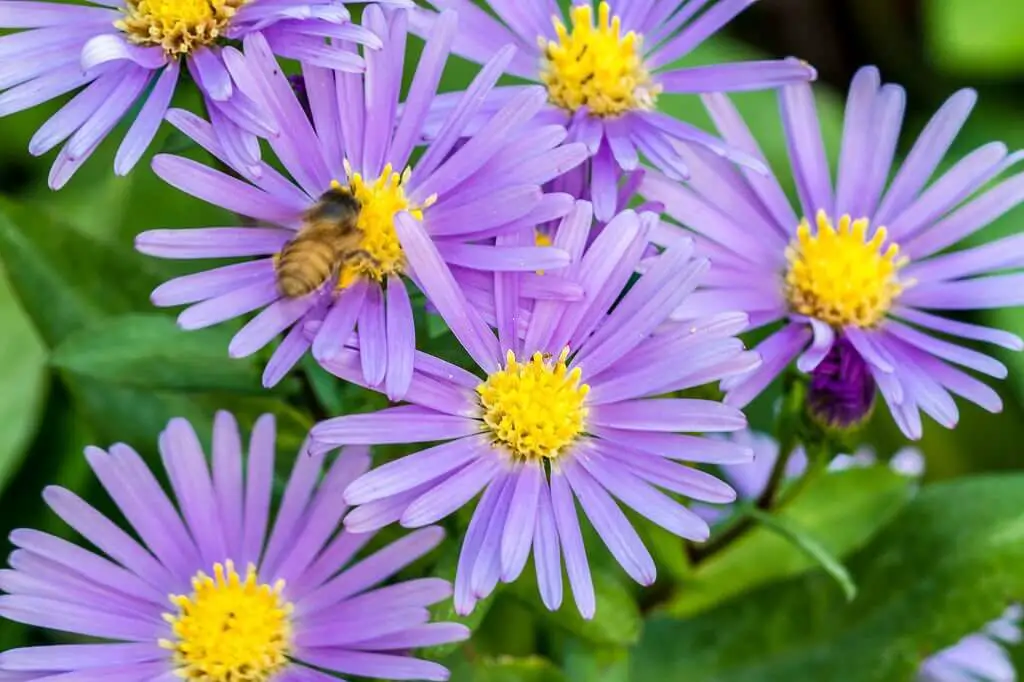
Last Chance Townsendia is a rare perennial plant that grows less than a foot tall. Stems arise from a woody root and branch to form a low tuft of foliage. During the spring, this plant bears a cluster of yellow radial flowers, which measure about an inch across. The flowers, which are borne in clusters, open in May. Bees pollinate the flowers.
- Light: Full Sun
- Flower color: Yellow to golden on the upper surface and
purplish and glandular below
14. Townsendia Annua
The annual plant, Townsendia annua, was first published in 1957 in Gray’s Herb. Its leaves are cauline and grow three to twelve centimeters tall. Despite its common name, the plant has a confusing botanical name. It’s not exactly a daisy, but is a member of the easter daisy family. It grows in sandy soil, red clay, and alkaline flats between 1200 and 2100 m.
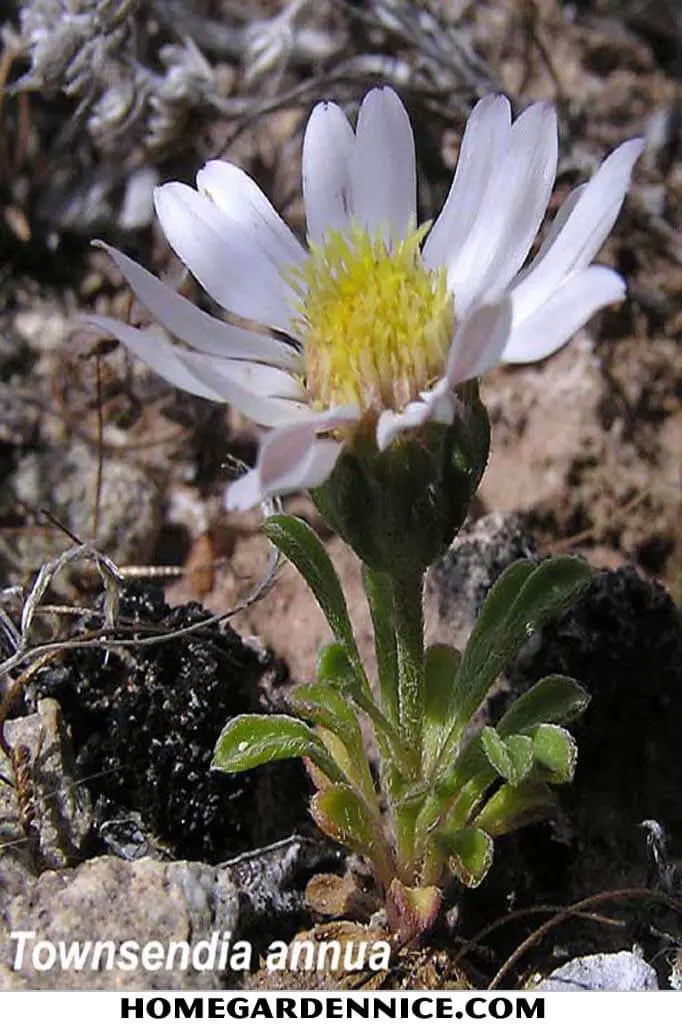
The taller form of this low-growing genus is the Showy Townsend Daisy. It produces several stems and narrow, hairy leaves. The flowers are almost white in color, with yellow disc florets. The leaves are often withered by flowering, and have bristly hairs. The Townsendia annua flower heads are about half an inch wide.
- Light: Full Sun
- Hardiness: USDA 3-9
- Height: 3-12cm
- Soil requirements: Sandy Soil, Red Clay
- PH: Alkaline
- Flower color: White With Yellow Disc Florets
15. Townsendia Jonesii
The Townsendia jonesii (Beaman) is a member of the Asteraceae family, . Its flowers bloom from Apr to June. It grows on limestone and rocky slopes and on pinyons in southwestern states. In addition to its common name, it is also known as Townsendia jonesii, T. jonesii, or T. scapigera.
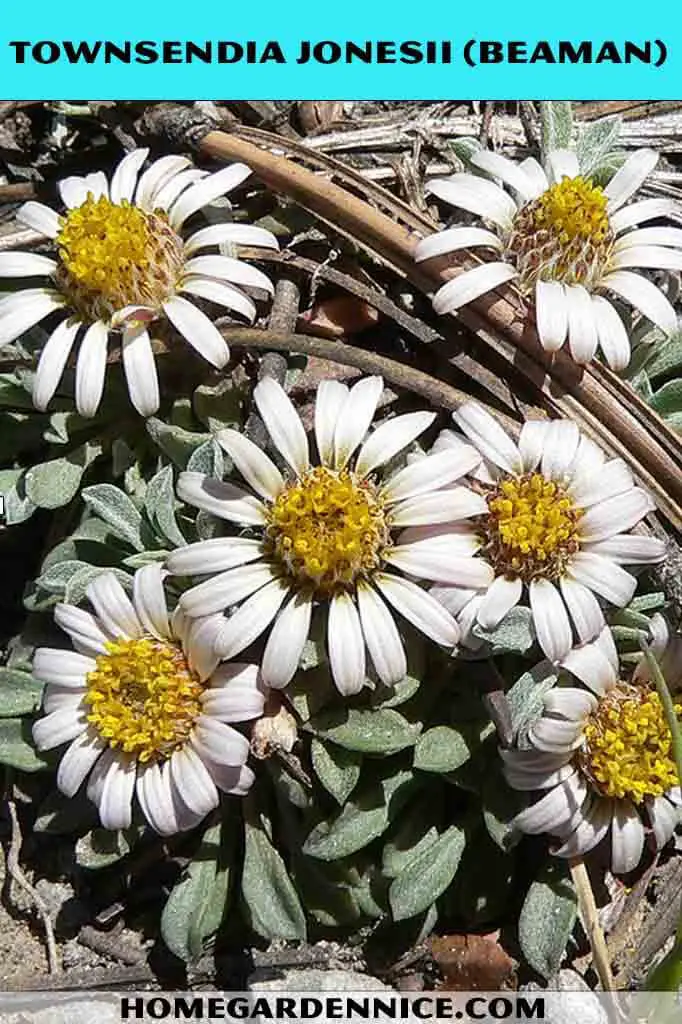
The plant is a perennial and has basal, cauline, and spatulate leaves. Its leaves are not fleshy and are scabrellous and strigose. It has a small, 8-14 mm-diam. flower spike is surrounded by tiny, rosettes. The involucres are 8-14 mm in diameter, and the phyllaries are lanceolate and glabrous.
- Light: Full Sun
- Hardiness: USDA Zone 3-9
- Height: 2 inches tall
- Flower color: blue, violet and white
16. Townsendia Alpigena
This plant is commonly called ‘Mountain Townsend Daisy.’ Its bright violet ray flowers are conspicuous. It is native to the Rocky Mountain corridor and has spread to several other states. This plant grows in open, dry areas with gravel and sand. It is also used as a medicinal tea and as a poultice against insect and snake bites. The plants’ seeds are not palatable but they are edible.
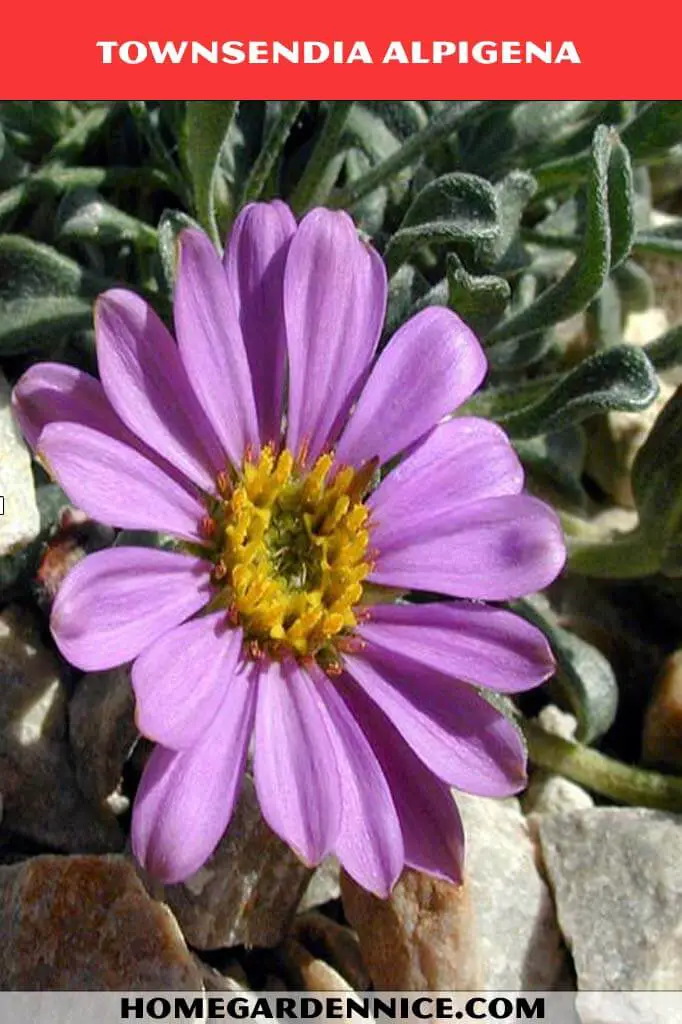
This subalpine plant is one of the largest and most popular alpine plants. It can grow from one to thirty centimeters tall. Its flower disk is 1.5-3 cm wide, with the involucre 9-16 mm high. The bracts are narrowly lanceolate and acuminate at the tips. In contrast, the petals of this plant are small and are oblong.
- Light: Full Sun
- Hardiness: USDA Zone 3-9
- Height: 6 inches
- Flower color: Bright Yellows And Deep Purples.
17. Townsendia Incana
The name Townsendia incana comes from the Latin word for “hoary” and refers to the white-hairy stems and leaves of this plant. This plant can grow anywhere from a few inches to several feet tall and is found in low-elevation woodlands, foothills, and spring openings. The flower heads of this plant range from white to pink with yellow centers, and are very showy. The foliage is lance-shaped and often has rough hairs.

This handsome American plant has long-rayed, golden-eyed flowers arranged at the end of the stem. The flowers open at the end of short stems that emerge above a silvery dome of leaves. The Latin word for “incana” means hoary, and the stems and flowers are whiter than the leaves. The flowers are large and the seeds are carefully separated from dead pappus.
- Light: Full Sun
- Hardiness: USDA 3-9
- Height: 1-5 inches
- Soil requirements: Sandy soils
- Flower color: Brilliant White But Are Often Tinged With Pink Or Lavender
Tribe: Anthemideae
The Anthemideae are a family of flowering plants within the asteroideae subfamily. They are widespread worldwide, with the largest concentrations in central Asia, the Mediterranean Basin, and southern Africa. The tribe contains approximately 1800 species in 111 genera. There are fourteen subtribes, including Glebionidinae (the source of garden marguerites).
Chrysanthemum and its allied genera are highly adapted and diversified, with low DNA divergence. These families show evidence of reticulation and introgression, but are otherwise weakly concordant with the other Anthemideae tribes. Fig. S1 shows coalescent analyses of plastid genes. This data reveals the phylogenetic relationships among the four subtribes of the Anthemideae.
Phyluce uses 929 nuclear COS loci while HybPiper uses 1047. Both pipelines produce identical phylogenies and report the number of loci retained per taxon. Phyluce also reports reads for each taxon. HybPiper and phyluce use a common ancestor to create the Fab Five. However, insufficient sampling is necessary to determine whether these two lines are closely related.
Types Of Daisies under the genus Argyranthemum
This group has a wide range of colors, including orange, yellow, and purple. Marguerite daisies grow to one to two feet tall. To grow these types in containers, you need potting mix; garden soil is too heavy for proper drainage. Once it has flowered, it should be pruned to keep it compact.
18. (Banana Cream Shasta Daisy) Reflection Yellow Cream Daisy
This double yellow cream daisy will delight gardeners with its beautiful banana-cream blooms and lush foliage. It’s perfect for a sunny border, mass planting, or as a cut flower. It grows between ten and fourteen inches tall. The double variety also grows well in containers. These daisies will bloom from May to June and then again into the fall.
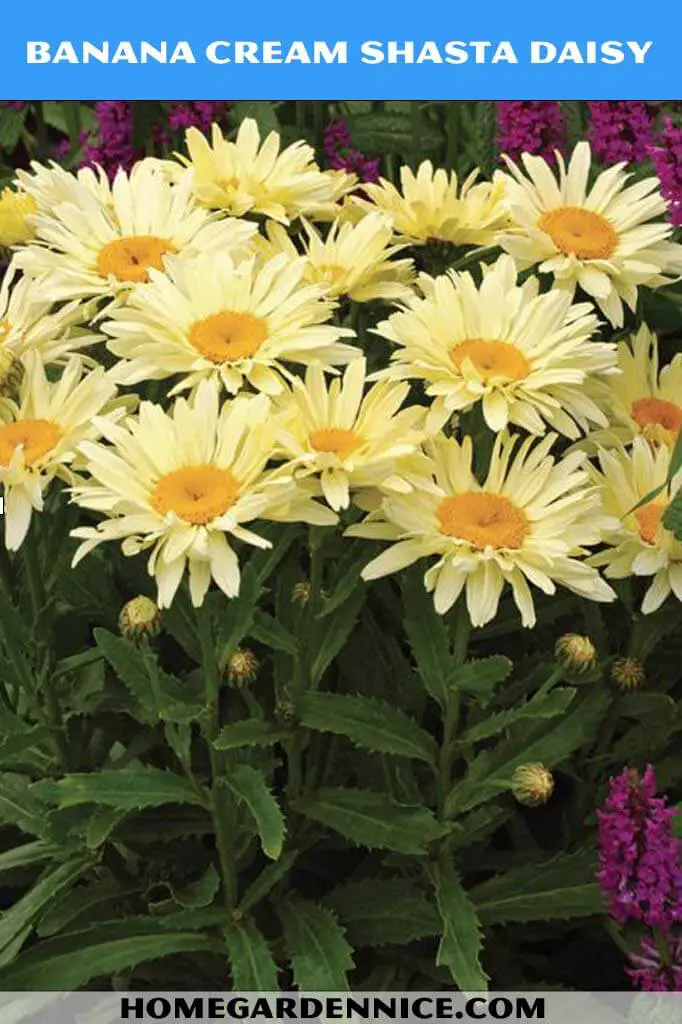
The banana cream shasta daisy is a perennial that is easy to grow and will tolerate a wide range of soil types. Plant it in a sunny location but a shady spot in the afternoon will help retain its yellow color. Daisies don’t mind most soil types, but they do need good drainage. They’re also not fussy about soil, so make sure to choose a well-draining spot.
- Light: Full Sun, Partial Shade
- Hardiness: USDA Zone 3-9
- Height: 10-14 inches
- Soil requirements: Any Soil Type But Needs Good Drainage.
- Flower color: Yellow Cream
19. Comet Pink
A stunning type of daisy that blooms in the spring is Comet Pink. The bright pink blooms contrast with the yellow center of the flower. The petals are similar to those of the common daisy. Comet Pink grows up to 14 inches tall and blooms in masses in the spring. It has a hardy pungency and is tolerant of salt splashes and wind.
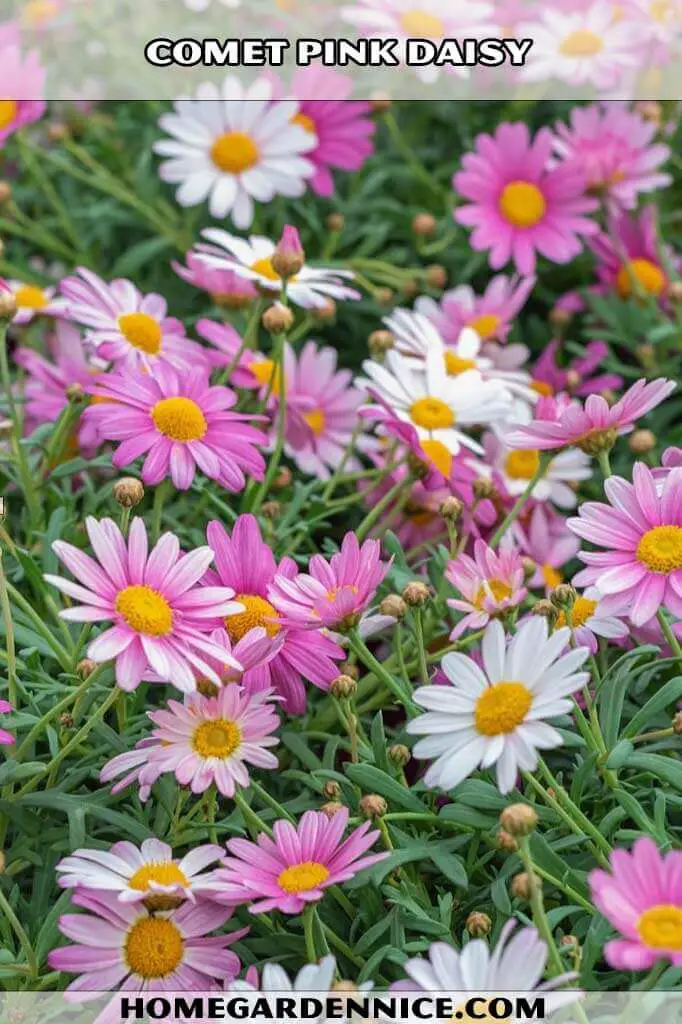
The comet white daisy is a native of the Canary Islands and is grown as a tender perennial. The small shrub has yellow-centered daisies on the top of its silver leaves. Comet White daisies do best in containers and bedding plants and require occasional maintenance and upkeep. This daisy attracts butterflies.
- Light: Full Sun
- Hardiness: USDA Zone 10-11
- Height: up to 14 inches
- Soil requirements:
- PH: Acid, Neutral
- Flower color: Bright Pink With Yellow Center
20. Supernova Carmine
This striking, large, daisy is known for its beautiful flower petals, which are pink with a lemon center. Its foliage is blue-grey and its habit is compact and sunny. In full sun, it thrives. In winter, it tolerates light frost. Its long flowering period and vigorous growth make it an excellent choice for the cottage garden. It is a good choice for gardeners looking for a flower with an unusual color combination.
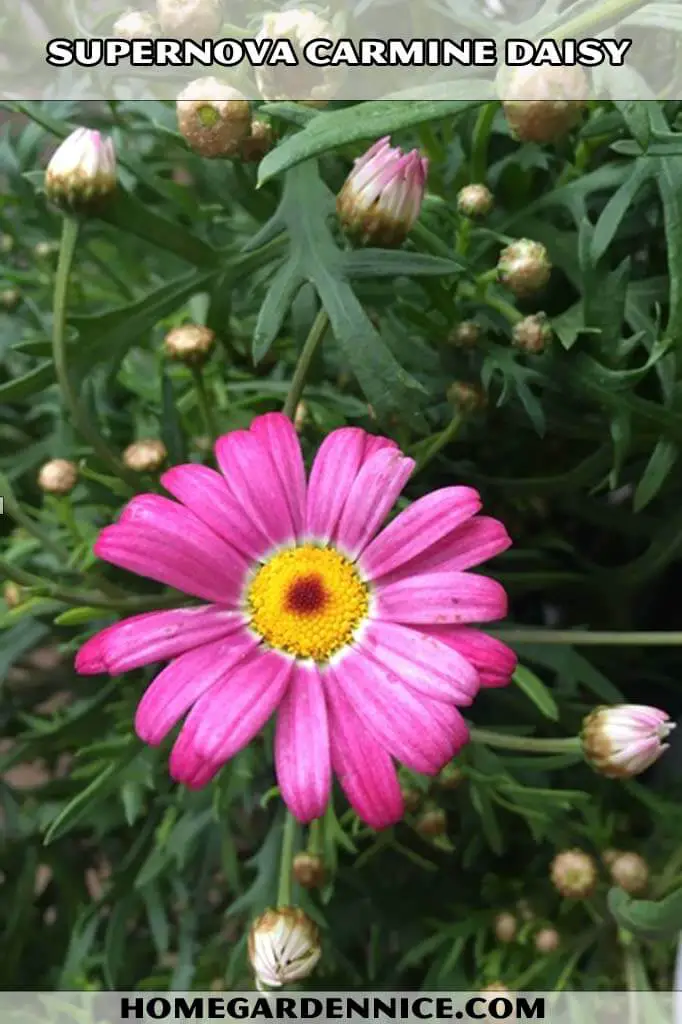
This flower is popular because of its medicinal value. It is easy to grow and needs a well-drained soil and full sun. It is a perennial that produces bright, massed flowers from late spring into late summer. This plant also has a compact habit and spiny blue foliage, which make it a good ground cover. It blooms in late summer and early fall and produces a rosy carpet of small flowers.
- Light: Full Sun
- Height: 60-70cm
- Soil requirements: A Well-Drained Soil
- Flower color: Pink With A Lemon Center
21. Argyranthemum Haouarytheum
The genus Argyranthemum is found in a variety of habitats, including oceanic islands, deserts, and wetland areas. There are four main species of Argyranthemum and several subspecies. The name “haouarytheum” is derived from its Latin name, which means “forest flower.”
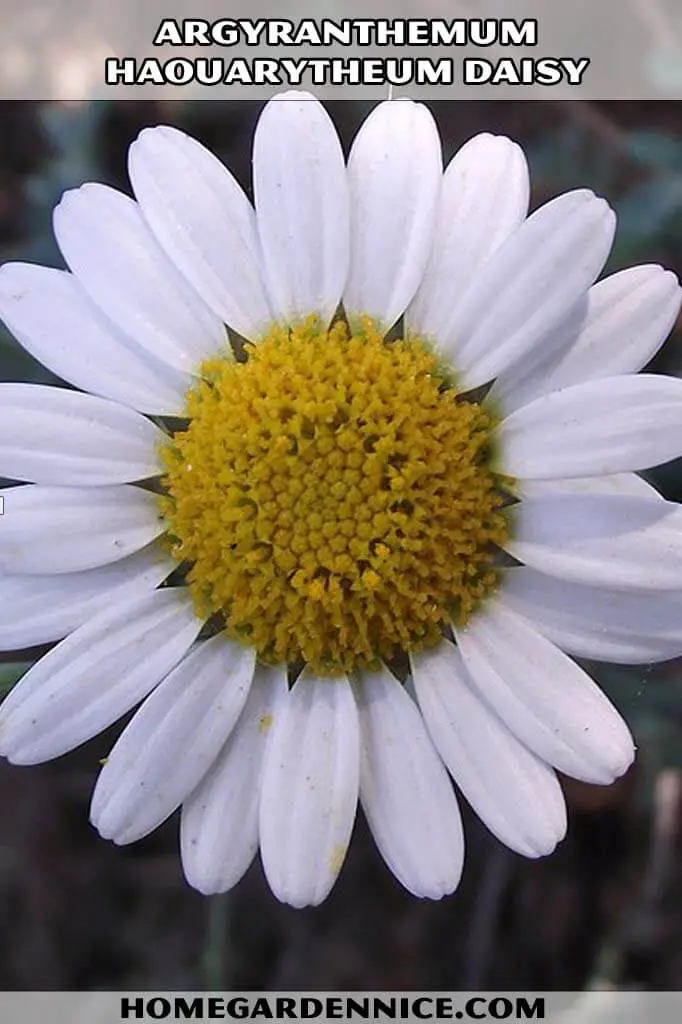
Various hybridization attempts have been conducted. In one of these attempts, L versicolor and Glebionis sp. served as the male parent. A total of 165 self-pollination crosses were successfully performed. This study has shown that the aneu-tetraploid Argyranthemum has the potential to hybridize with other species. Regardless of the resulting hybrids, this species has the potential to grow in the wild.
- Light: Full Sun
- Height: 15-30 cm
22. Bright Carmine Daisy
If you’re interested in growing a variety of bright carmine daisies, consider the coneflower. This cultivar of daisy has long, wavy petals that begin deep purple and fade to off-white as they reach the center of the flower. The long, slender blooms will add class to your flower bed, border, cottage garden, or wild meadow. This daisy grows best in full sunlight and requires consistent moisture in the soil. It is hardy in USDA zones 3-8 and is suitable for container gardening.

The Sunflower family includes the popular geranium and coneflower. This group of flowers is native to the lower 48 U.S. states, where they can thrive in sunny or partially-shaded areas. They are tolerant of full or partial sun and are easy to grow. They will grow up to three feet tall and can tolerate both acidic and alkaline soil. Bright carmine daisies are a great addition to a garden, and can be grown in most soil types.
- Light: full sun, partial shade
- Hardiness: USDA zones 3-8
- Height: up to 90cm
- Soil requirements: most types of soil
- PH: acidic, alkaline
- Flower color: deep purple, off-white
Types Of Daisies Under The Genus Chrysanthemum
If you are looking for a flower that looks as pretty as a daisy, you might want to know about the different types. This section will provide you with information about the Chrysanthemum Japonense, Chrysanthemum Weyrichi, and Painted Daisy. Below, you will find a description of each type.
23. Chrysanthemum Weyrichi
Chrysanthemum weyrichii is a low-growing, perennial mum that is native to Japan and the islands between Kamtschatka and the Kamchatka peninsula. Its long, fragrant blooms are a common sight in gardens and can be found in many types of arrangements. While it is difficult to grow, it is easy to propagate from cuttings or divisions of the main plant. The adventuring stolon is a good choice for cuttings, too.
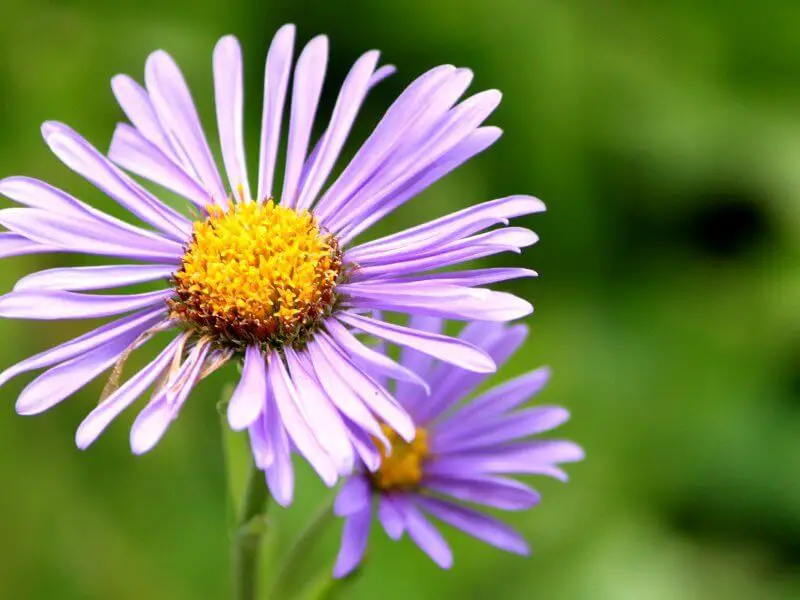
The flowerheads of Chrysanthemum ‘Weyrichi’ are upturned and surrounded by a yellow button center. The plant produces clusters of flowers on woody stems and forms a cushion of semi-evergreen foliage. The plants are deer-resistant and easy to grow. These beauties make great containers and border plants. However, if you do decide to grow them in the garden, make sure they’re deer-resistant and in full sun.
- Light: full sun
- Hardiness: USDA Zone 4-9
- Height: up to 300cm
- Soil requirements: Clay, Loamy, Sandy
- PH: Acid, Alkaline, Neutral
- Flower color: White, Pink in Autumn
24. Chrysanthemum Japonense
There are many varieties of chrysanthemum. These flowers are divided into two groups: exhibition and garden hardy. Exhibition mums are less durable than garden hardies, but they produce an abundance of small blooms, so they’re generally a better choice for gardening. The garden hardy variety is ideal for garden conditions because it can be wintered in the ground. It will grow well in warm climates, but it may need staking to protect it from the cold. Nevertheless, this cultivar can be used to create numerous artistic forms.
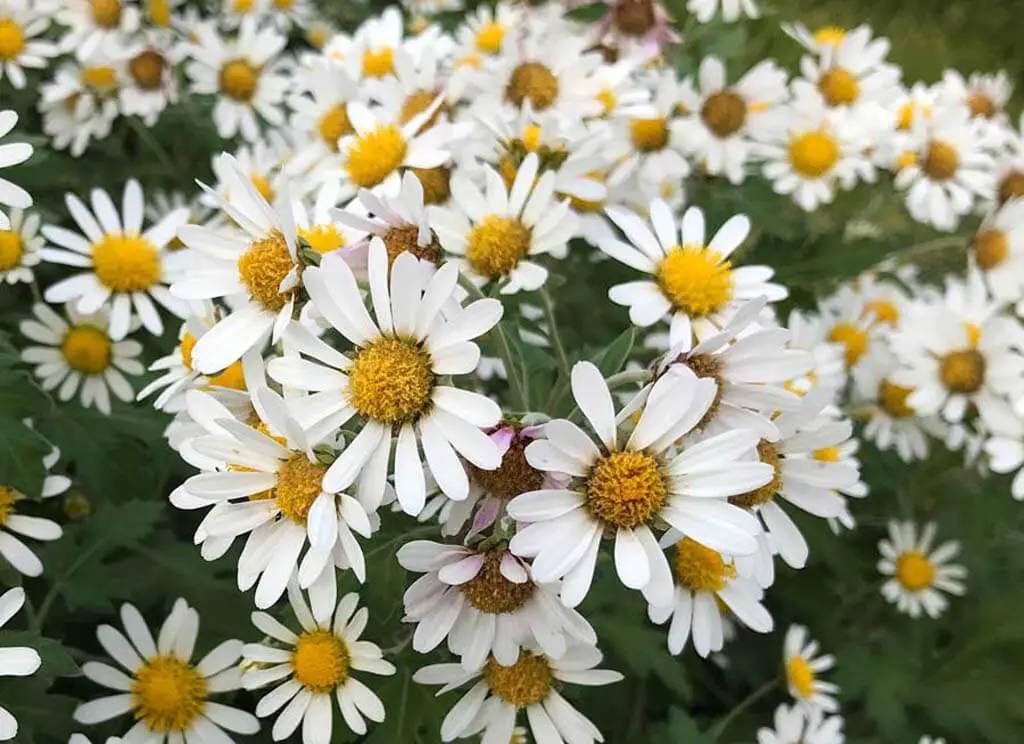
In Japan, chrysanthemum growing is still a popular pastime. Some Japanese people create chrysanthemum “dolls” that depict fictional characters, usually from Japanese kabuki and Disney. The city of Nihonmatsu even hosts an annual Chrysanthemum Dolls Exhibition. People also cultivate these plants as bonsai. The Chrysanthemum Throne is named after the Japanese Emperor. The emperor awards the Supreme Order of the Chrysanthemum to those who display a good collection of these flowers.
25. Tiger Tail Chrysanthemum
A perennial shrub with ferny leaves, Tiger Tail Chrysanthemum produces gorgeous, double, salmon-orange flowers. They bloom for three to five weeks and develop yellow overtones as they mature. The flower heads are excellent for cutting. The foliage is aromatic and has a fine texture, making it a good choice for both potted and garden plantings. During its early spring blooming, Tiger Tail Chrysanthemum will reach a height of about 4 feet tall and 5 feet wide.

This chrysanthemum grows well in both partial shade and full sun. It is not susceptible to many common diseases and pests. Although they are susceptible to leaf miners, these pests pose little threat to the overall health of the plant. Their stalks will catch snow and dead leaves, providing protection through the winter. Planting mums in the spring is best, as it allows them to root and grow properly.
- Light: partial shade, full sun
- Hardiness: USDA zone 4-9
- Height: up to 120cm
26. Painted Daisy (Chrysanthemum Carinatum)
The painted daisy is a perennial flower that is native to southwestern Asia. Its large, slender flowers are borne on sturdy stalks, and its elegant foliage makes it a valuable cutting plant. The flowers last up to three times longer than roses, and their natural insecticide, Pyrethrum, is often extracted from the flowering buds. The flowering pyrethrum is used in organic insecticides, but is harmless to other plants and animals.
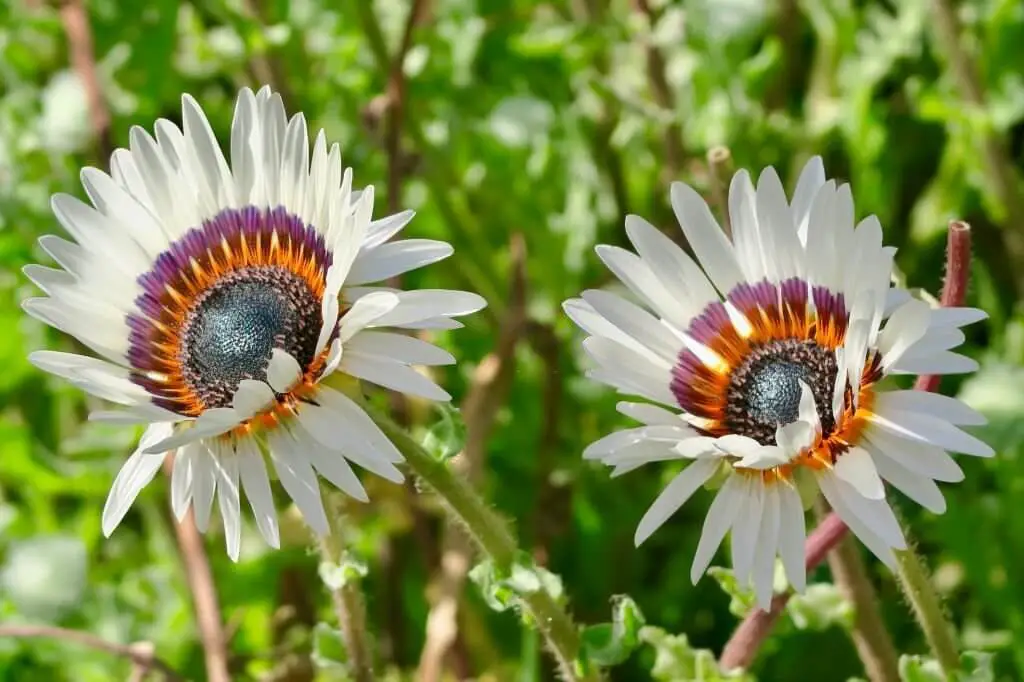
A painted daisy is very easy to grow in garden soil. A moist atmosphere is ideal, and the plant prefers well-drained soil. However, don’t overwater the plant! It will suffer from a fungal infection if the leaves are watered too often. Instead, water the roots with a hose or drip irrigation system. The painted daisy can tolerate some drought, so rainfall is enough in temperate climates. However, during hotter weather, the plant will need watering. However, make sure to don’t water the plant so much that the roots are rotted.
27. Chrysanthemum Indicum
Chrysanthemums are a group of flowering plants with a range of unique properties, ranging from the color of their petals to their shape and growth habits. Generally, the petals of chrysanthemums are narrow and cupped in the center, and some varieties are more similar to spider flowers with a hook or coil on the flower’s tip.

Despite their colorful appearance, some chrysanthemums are susceptible to mildew, so make sure that your plant is planted in an area that is well-drained, and that has a lot of sunlight during the morning. They also do not do well in compacted soil or low-lying areas, and should not be planted in a spot that is poor.
Types Of Daisies under the Genus Leucanthemum
There are many different types of daisies. The English daisy is a classic example with a yellow center and long white petals. This flower originated in Northern Europe and has become a weed in the United States. However, there are many other varieties of daisies that have a better reputation. In this article, you’ll learn about the Shasta Daisy, Portuguese Feld Daisy, and Becky Daisies.
28. Leucanthemum Becky
This heat-tolerant variety of the Shasta daisy is named after a Georgia gardener, Becky Stewart. Becky daisies have large, yellow centers, are upright, and grow above deep green foliage. They are attractive cut flowers and do well in the middle of the garden. A great choice for a cut flower arrangement, this plant will grow well in containers and the ground. You can cut blooms as they develop.

Leucanthemum Becky is commonly propagated vegetatively. The cuttings should be taken from the tips of non-flowering shoots, which will root easily within three to four weeks if properly cared for. Although Becky cuttings may appear wilted when placed on the misting bench, this is normal and will stop once they have formed roots. You can dip the cuttings in a rooting hormone of 1,500 ppm to ensure a vigorous plant.
- Light: Full Sun
- Hardiness: USDA Zone 4 – 9
- Height: 36-48cm
- Soil requirements: Sandy Soil, Clay Soil, Compost Enriched Garden Loam Soil
29. Crazy Daisy
This hardy plant grows from one to three feet tall and is USDA hardy in zones 9 through 11. It prefers moist soil with a neutral pH. It has a dark purple disk in the center of its yellow petals, making it a stunning addition to any garden. Plant in borders or use it as a border framer. Thrives in USDA zones 4-7. This is one of the most popular daisies, so get some!
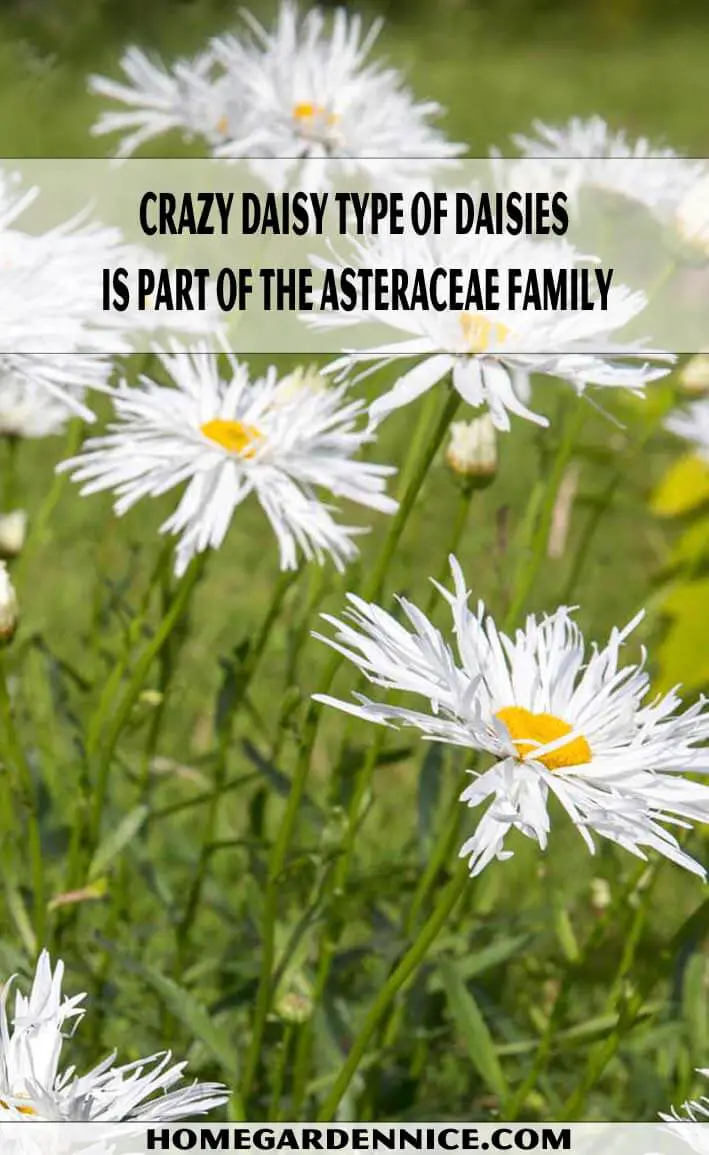
The Crazy Daisy Type Of Daisies is part of the Asteraceae family, and includes many daisy-like species. These flowers grow well in a wide range of planting zones and are remarkably drought-tolerant. They can be found in yellow, orange, and purple, and are chemical-free. Their unique seeds are a perfect blend of beauty and function. If you’re looking for a unique and beautiful flower, the Crazy Daisy Collection is for you!
This variety has a wholesome appearance with long petals and a yellow disk. Its blooms last from spring to autumn and are two inches in diameter. Planting them in containers or next to a wall will help them bloom more profusely. Gerbera daisies are hardy in USDA zones nine through 11 and need well-drained soil with a neutral pH level. These beauties are wonderful in containers, and they look great in front of flower beds.
30. Portuguese Feld Daisy
The Portuguese field daisy is a cross between the English field daisy and the oxeye daisy. It is a member of the family Asteraceae and belongs to the genus Leucanthemum. These daisies are tall, spreading plants with yellow flowers. Their petals are up to four inches long and their stems reach more than four feet.
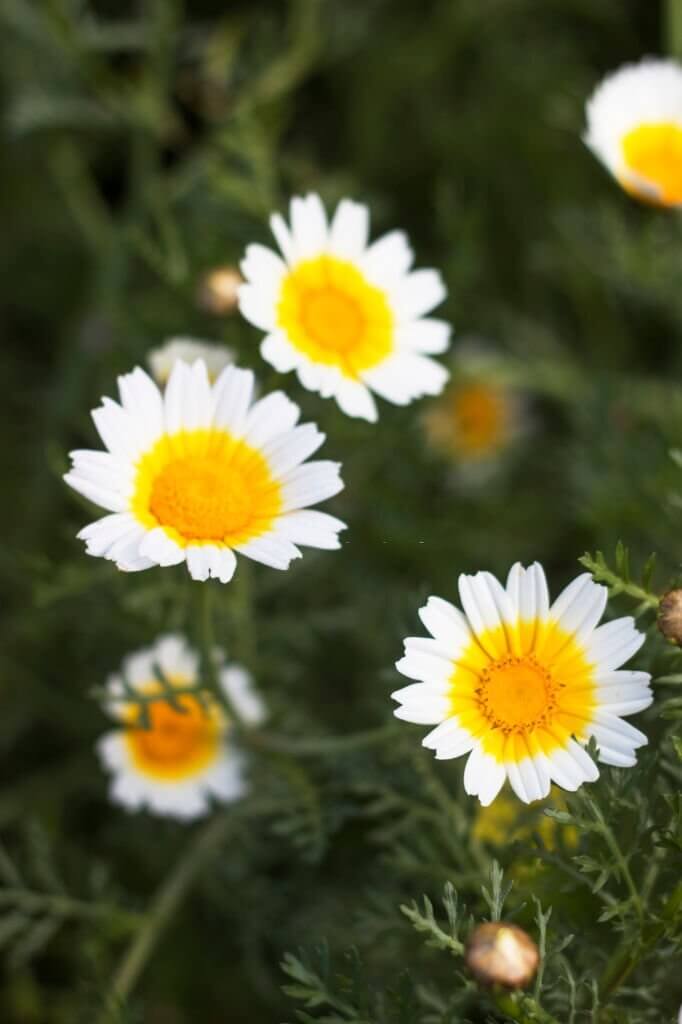
The ox-eye daisy, scientifically known as Leucanthemum vulgare, is native to temperate areas of Asia and Europe, but has been cultivated in North America, Australia, and New Zealand. Its common name, “ox-eye daisy,” refers to the center disk of the flower. Leucanthemum’s name is derived from the Greek words leukos and anthemon, which mean “white” in Greek.
31. Shasta Daisy
The Shasta Daisy (Leucanthemum maximum) is a hybrid that is popular in horticultural circles. It is native to the Mediterranean region, but has since become a worldwide favorite. Though most perennials do not bloom their first year, this plant does take a year to establish itself and bloom. Fortunately, its beautiful flowers will make your garden the talk of the neighborhood!
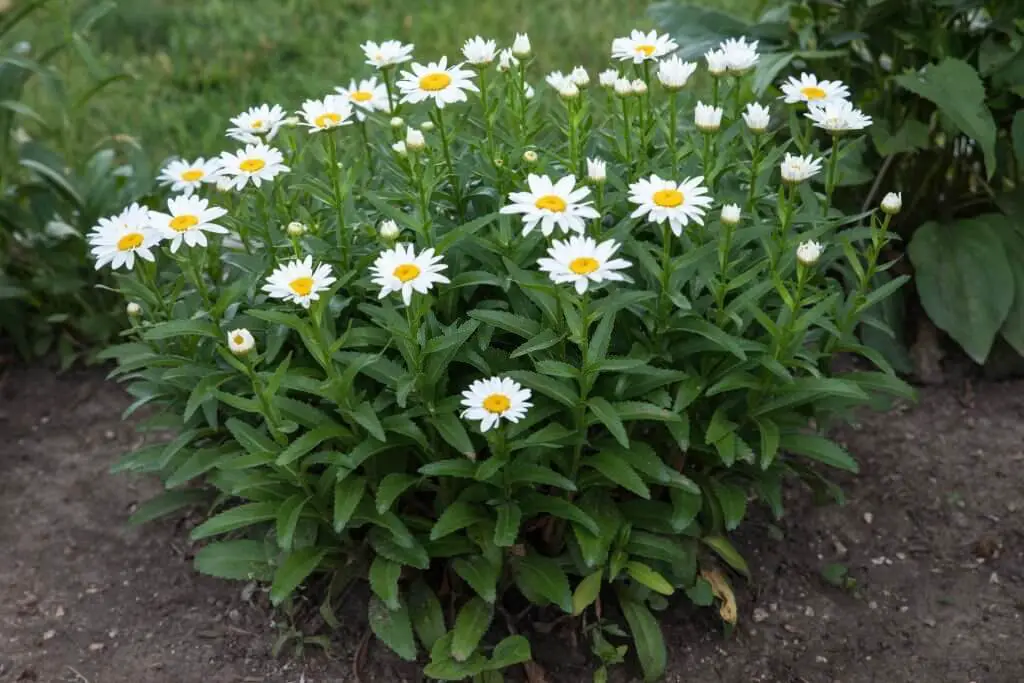
A hardy perennial, Shasta daisies will come back each year, even after freezing winters. Their short lifespan means you must divide them every couple of years to avoid overcrowding. You can also use a staking device if your plants are too tall. Once they are established, you can fertilize them with an all-purpose granular in April. You can also grow them from seeds, starting them indoors in peat pots or in cold frames in the fall. Alternatively, you can direct-seed them directly into the garden and enjoy blooms within one year.
- Light: Full Sun
- Hardiness: USDA Zone 4 -8
- PH: neutral
- Flower color: white
32. Oxeye Daisy
This flower is native to Europe, but it has become naturalized in Minnesota. The species of Oxeye Daisy is found in counties east of the diagonal line extending from Fillmore County to Norman County. The common species is Leucanthemum vulgare, and it was collected in Hennepin County in 1878. The Giant Daisy, on the other hand, grows only in Cass, St. Louis and Hennepin counties.

Despite its common name, the genus is somewhat disputed and the plant is found in many home gardens. This plant grows on erect stems that may be eight to twenty-four inches tall. The stems are usually hairless but may have grooves or angled edges. The plant’s acrid juice deters insects and browsing animals. This is one reason why it is often called the “bane” of hay fields.
Tribe: Calenduleae
The flowering plant tribe Calenduleae is part of the Asteraceae family. This tribe has been recognized since the early 19th century, when Alexandre de Cassini categorized the group. Today, there are 110 species in eight genera, mainly in Africa and South America. There are several species that are endangered and sadly, not available for sale. But, don’t despair, there is still hope!
The tribe comprises plants that range in size from shrubs to grasses. The showy flower heads are often referred to as calendula. The family also includes Dimorphotheca and Osteospermum, which are ornamental. Calendula is commonly used as a homeopathic medicine. While other genera are used for ornamental purposes, the Calendula family has a long tradition as a source of inspiration for artists.
Phylogeny based on plastid and rRNA genes is supported by the results of ASTRAL phylogeny. These data support a monophyletic Fab Five Clade. The Asterodae is the earliest diverging lineage and has a LPP of 0.57. Three remaining tribes support monophyly, whereas the Gnaphalieae and Anthemideae are sister groups.
Types Of Daisies From The Genus Osteospermum
When it comes to flower types, the genus Osteospermum has a lot of choices. Unlike many other plants, daisies have a central disk flower called the disk flower, and ray flowers that surround the disk. These ray flowers have what appear to be sepals. In reality, they are actually phyllaries, which protect the receptacle that contains all of the petals.
33. Whirligig Daisies
You can find Whirligig Daisies at the Winegar Backyard in Palm Bay, Florida. The name refers to the rounded and scalloped petals of these African Daisy hybrids. They can grow up to 50 cm high and need plenty of sun for blooming. The plants grow well throughout the year and bloom profusely. Most types of the daisy have single or semi-double petals, but the ‘Whirligig’ has spoon-shaped petals.
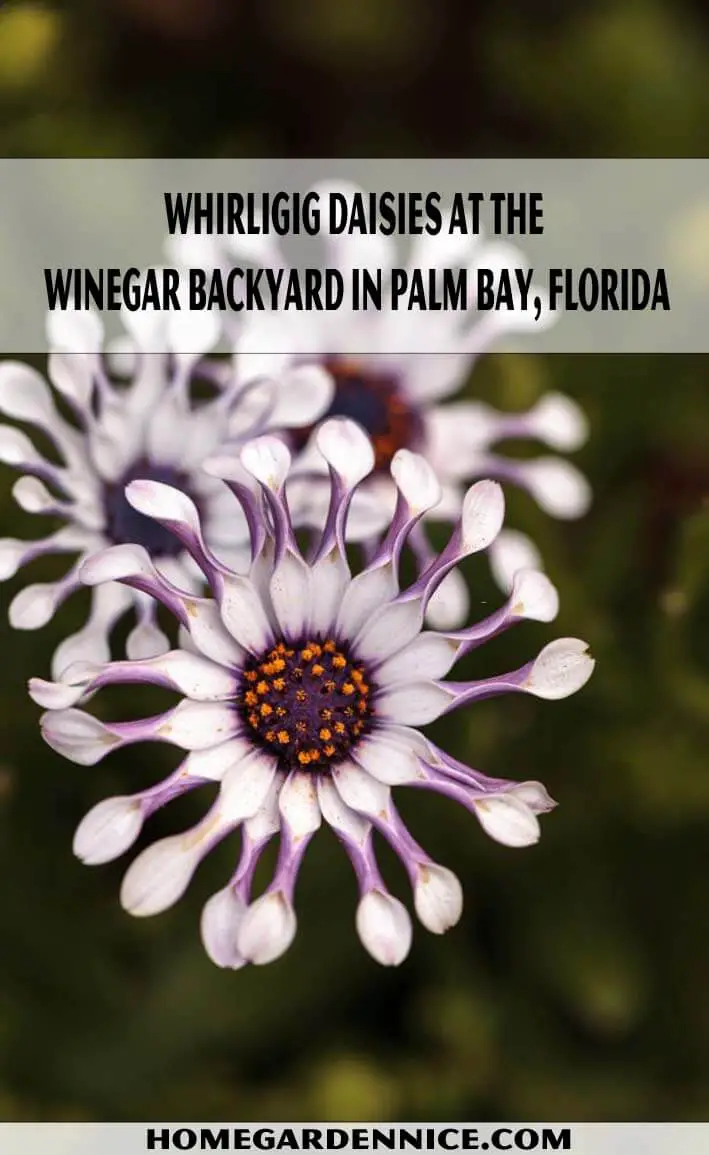
The flowers are large and form a stunning summer display. The flowers of whirligig daisies are either single or semi-double. These flowers have a pointed tip on the bottom and can be planted in plant pots or directly into the ground. The Whirlies are made of high quality materials, including top-grade paints. These flowers come in a wide range of colors, including white, tan, and grey/white.
- Light: Full Sun
- Hardiness: USDA zone 10-11
- Height: Up to 50cm
- Flower color: white flowers with a blue center and deep purple edging
35. South African Daisy
The Trailing Ice plant is a native of South Africa and features pretty flowers. It is drought-tolerant and grows up to 18 inches tall and 24 inches wide. It makes an excellent ground cover plant and a great addition to a rock garden. Trailing Ice plant belongs to the sunflower tribe and is native to dry grasslands and scrub in central and southern Africa. It is a perennial and grows as a creeper or erect plant.
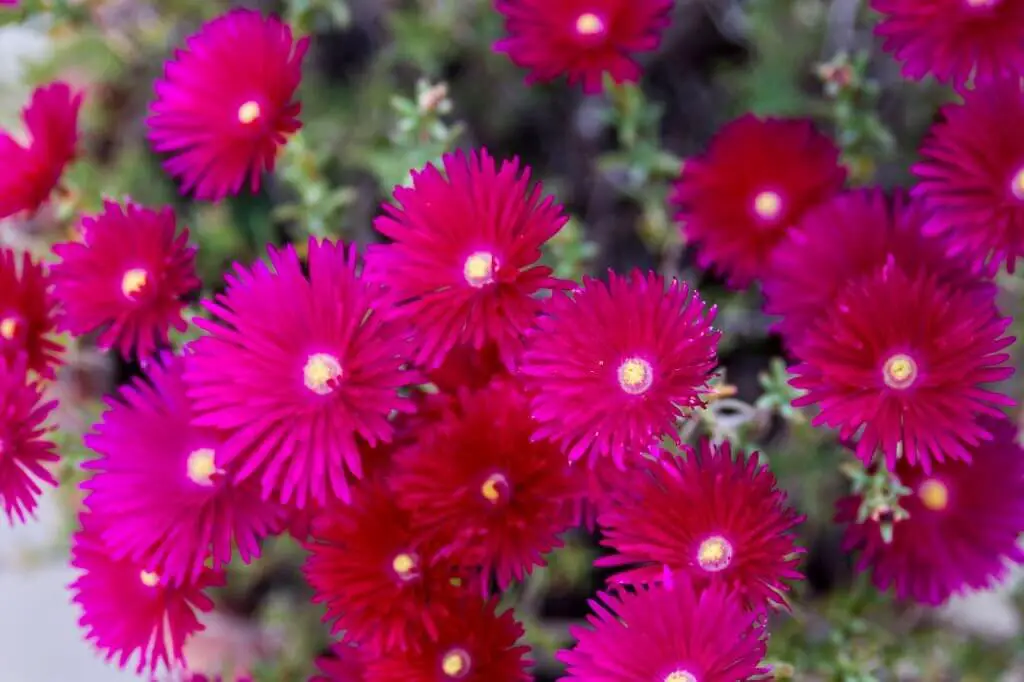
Cape daisy requires warm, moist soil. This flower loves warm soil and should be planted in a south-facing balcony. Be sure to use a lightweight mix of sand or a soil-based potting mix for the best results. Water regularly to enjoy the colors of this plant. It will bloom from July to September. You can even plant seedlings in a pot for an easy flowering annual.
36. Cape Daisy Purple Illusion
The Cape Daisy, also known as the Blue-eyed Daisy, is a low-growing shrub with daisy-like flowers. Its foliage is a velvety silver-green. The flowers have multiple petals that can range in color, with a dark bronze to black center. In addition, the flowers are drought-tolerant. While not hardy in the coldest climates, they do well in USDA hardiness zones three to ten.
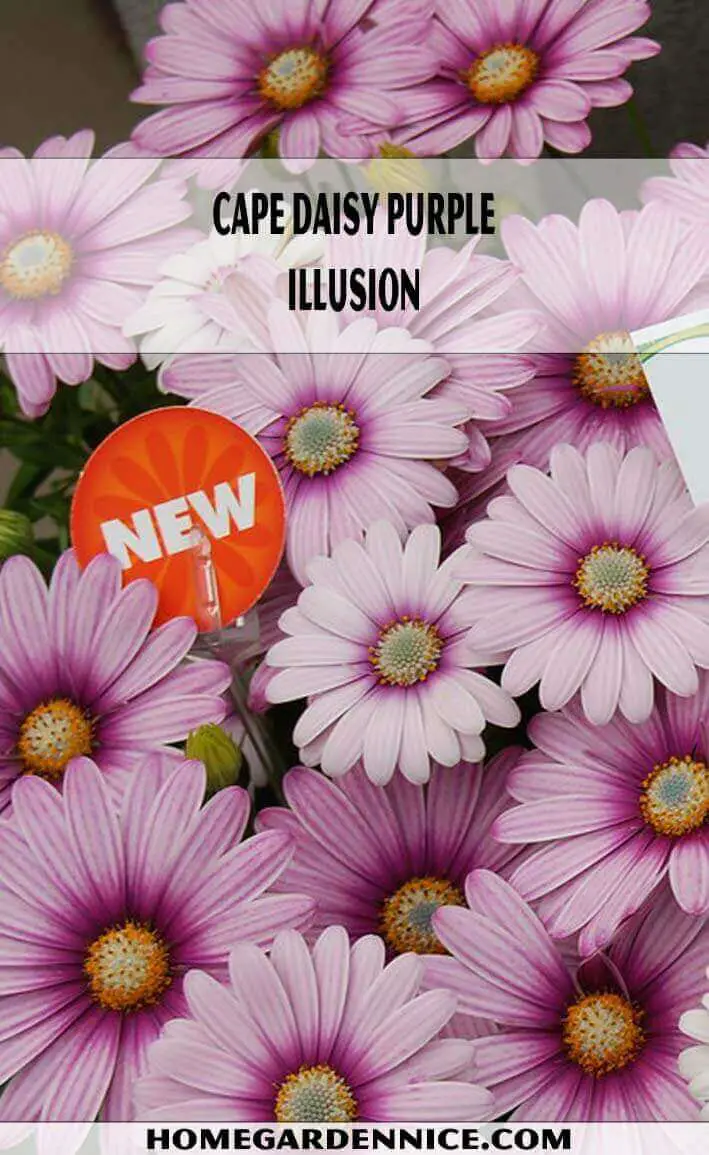
Another popular perennial that grows well in cool climates is the Osteospermum. This plant has bright, cheerful lavender-purple flowers that have blue eyes. It blooms from mid-spring until the first frost and can be used for cutting. It has upright stems and lanceolate green leaves, making it ideal for sunny borders. Its flowers are also great for making arrangements. Its spongy foliage makes it an excellent choice for containers and hanging baskets.
37. Magarita Bronze Daisy
If you’re looking for an unusually colored African Daisy plant, look no further than the Margarita Bronze Bicolor Osteospermum Plant. This unusually colored plant deviates from the traditional purple and white varieties with its long, ridged petals and pastel yellow flowers with a deep yellow eye.
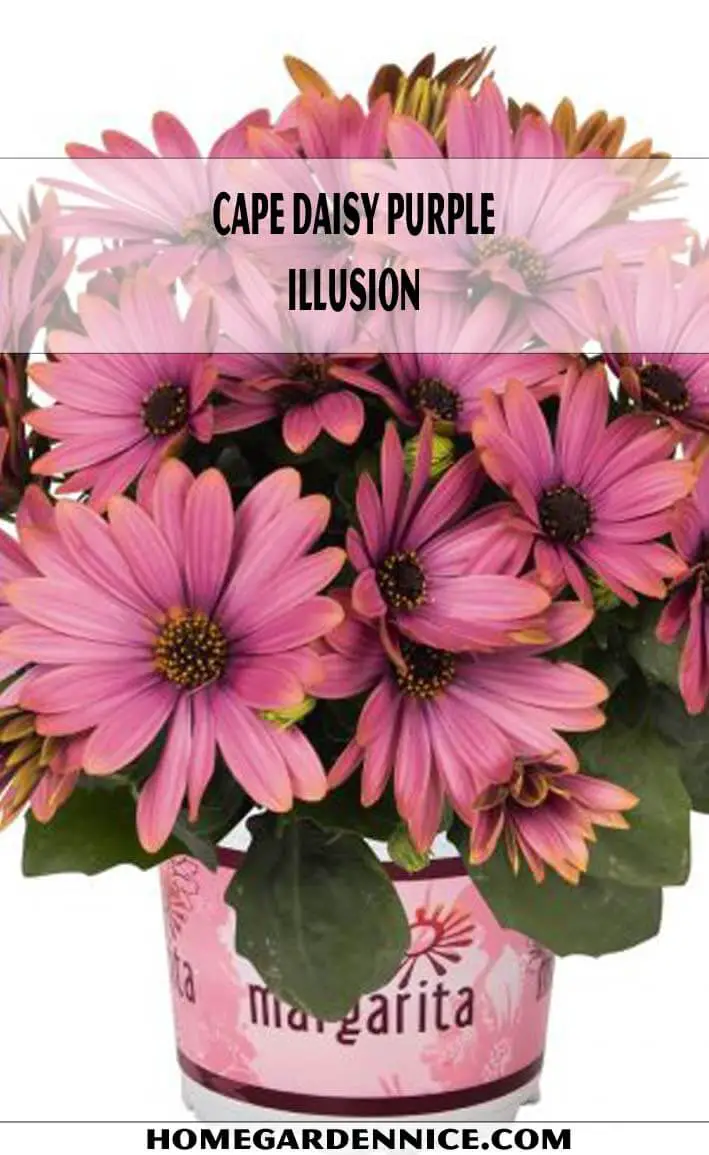
These colorful flowers are a welcome change from the common, white African Daisy. In a 5.0-inch pot, these plants require only 0.8 cups of water each day. For a more personal watering schedule, you can download a free Greg app or use a water calculator.
Tribe: Heliantheae
The daisy family consists of many genera and species, including sunflowers, jerusalem artichokes, and coreopsis. Other members of the family include chaff-scaled weeds, such as zinnia, and a few weeds. Ambrosia, a member of the tribe, produces large amounts of pollen, which can trigger allergic reactions and lead to hay fever.
The sunflower is the most commonly recognized member of this tribe, but many of its members are also shrubs. These daisies produce small flowers, called capitulum inflorescences. Sunflowers, for example, have ray florets that are bronze. In contrast, the yellow-flowered Ratibida columnifera has tiny flowers. There are approximately 2,500 species in the tribe, making it the largest family in the Heliantheae subfamily.
Types Of Daisies under the genus Echinacea
You’ve probably seen them around, but have you ever wondered what each of the different types of daisies is called? Here are some common names and descriptions. This section will cover the most popular types of daisies, including the Cherokee Sunset, Smooth Con Flower, and White Swam. You’ll also learn what makes them unique and useful for your garden. You’ll love this plant’s beauty and health benefits.
38. Purple Cone Flower Daisy
The most beautiful flowers on earth are those which attract pollinators. The Purple Cone Flower is no exception. Its brightly colored petals have plum centers. This perennial plant is a good plant to grow in your garden. Purple coneflower seeds need to be dried before planting them. Once planted, they should be flat and about five millimeters deep. Then, spread them onto a screen or paper plate. Before storing the seeds, allow them to dry for at least 30 minutes.
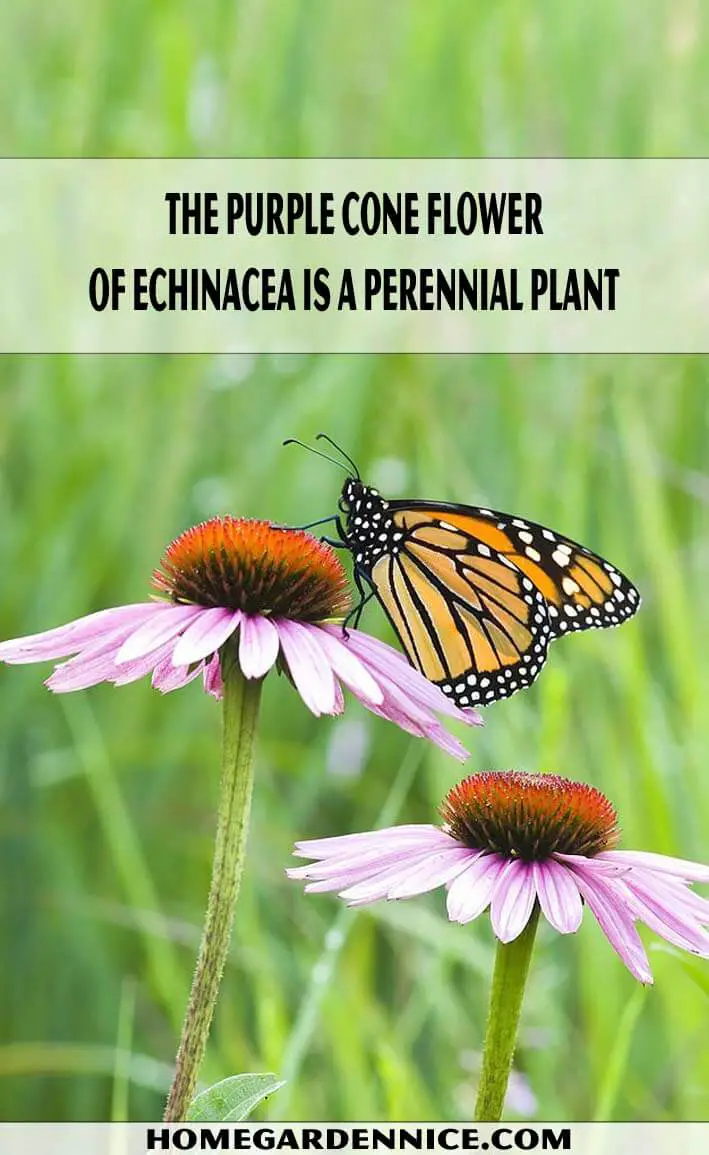
The Purple Cone Flower of Echinacea is a perennial plant that is a hardy and tolerant plant. It blooms in spring and late summer, resting in July and August before going dormant. It is perfect to grow in full sun or partial shade. Some cultivars have even double petals, making them attractive to bees and butterflies. They are hardy in USDA zones four to nine.
39. Smooth Con Flower (Echinacea purpurea daisy)
The U.S. Fish and Wildlife Service is proposing the downlisting of the smooth coneflower, a species that was listed as endangered in 1992. Based on current information, the species is no longer endangered but is considered threatened in the near future. It is not invasive, but may be threatening to other species. While the smooth coneflower is not currently endangered, it is likely to become so in the near future.
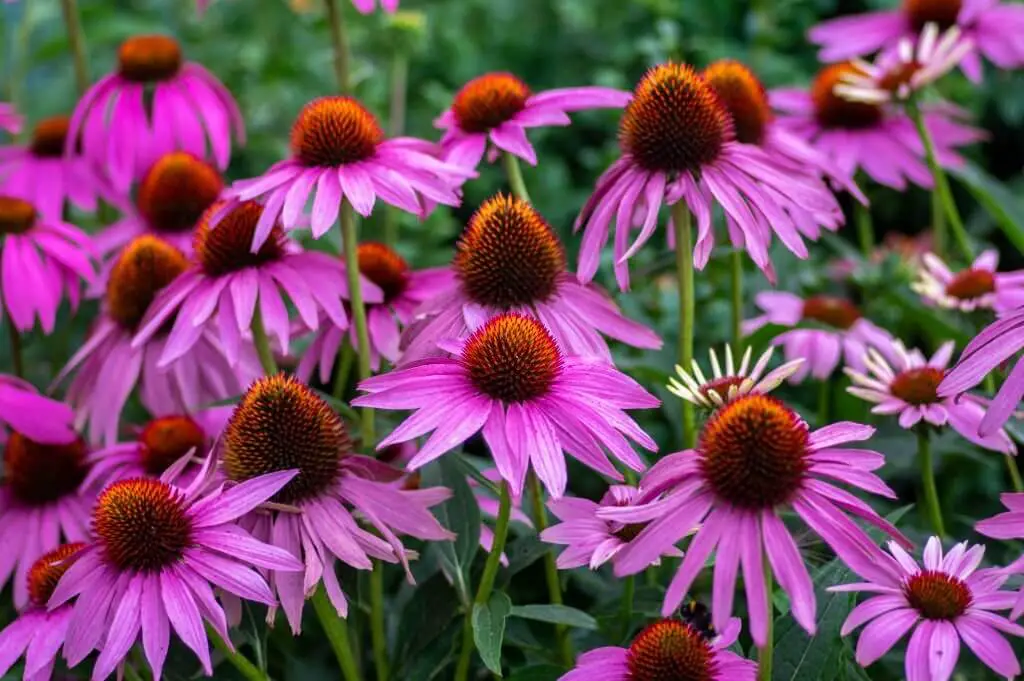
The aerial parts of Echinacea purpurea contain at least five acetylenic amides, the latter of which are related to the substance linolen. The plant parts have similar patterns of alkamides, although the levels of alkaloid precursors differ greatly. The vegetative stems and roots contain more C12 diene-diyne alkamides than the flowers do. The ratio of C12 tetraene alkamides in the aerial parts of Echinacea purpurea and ‘Smooth Con Flower of Echinacea’ differs between the two.
40. Summer Sky
The Summer Sky Type Of Daisy is a colorful plant with a brightly colored, semi-spherical center. These daisies bloom from late spring to early summer. The flowers have large, ruffled petals, and their bright yellow centers are eye-catching. The leaves are long and slender. Besides the bright colors, they also have a pleasant aroma. Summer Sky Daisies are native to the Philippines.
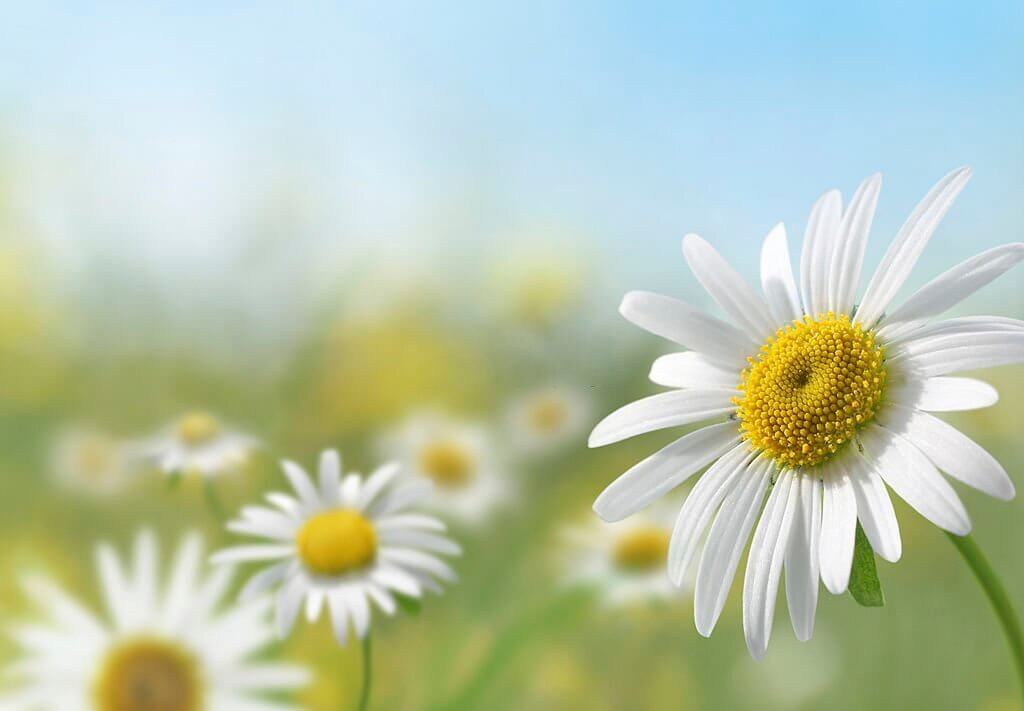
The Black-Eyed Susan is the official floral emblem of Maryland. It is also known by other names, such as daisies, coneflower, and chrysanthemum. The flower has a vase life of seven to 14 days. Several types of daisies are available for the home garden, including the conical coneflower. The flower is easy to grow, and requires little maintenance. If you live in a zone with hot summers and cool winters, consider growing these plants in the spring and summer
41. White Swam Daisy
There are many varieties of daisies, but the white swam variety stands out among them all. This daisy, also called the seaside daisy, grows on larger bushes and blooms in bright colors. Their flowers are large, ranging from yellow to orange and are surrounded by dark green foliage. They prefer full sun and soil that drains well, and they need regular watering to grow.
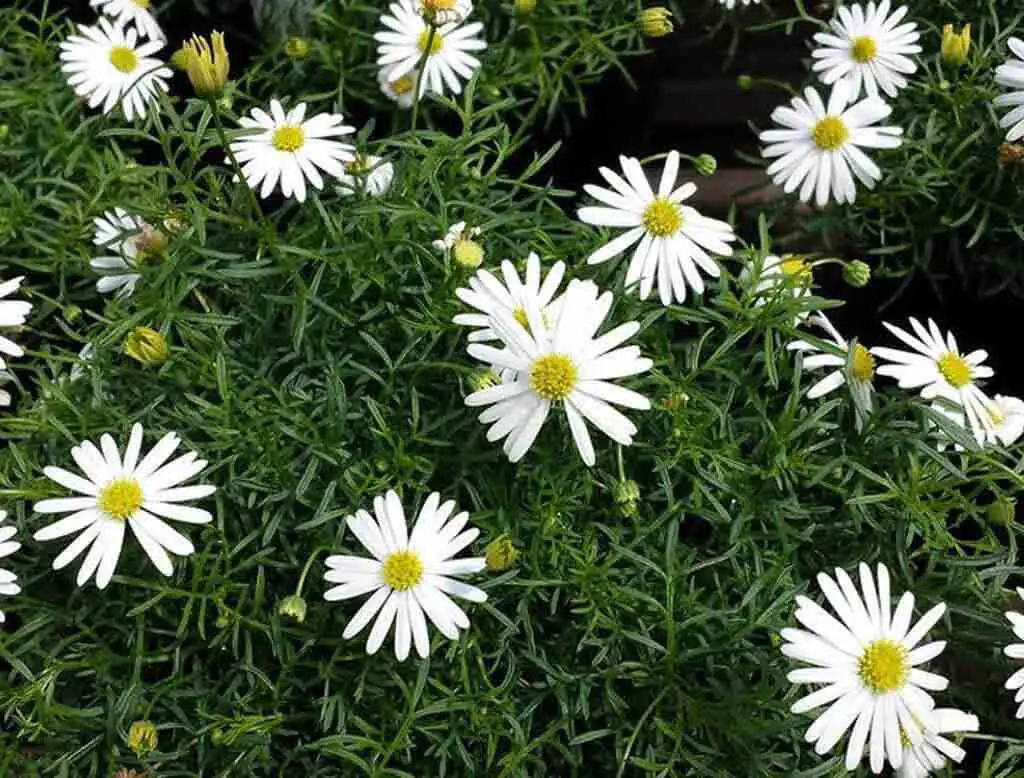
There are various types of daisies, including African ones. The black-eyed susan daisy is hardy and can be grown from seed. Its flowers are bright yellow with a yellow center. It requires six to eight hours of direct sun and moderate moisture. It grows best in sandy soil and requires moderate water. Once it blooms, you can harvest its flowers for a herbal tea.
Several types of daisies are considered invasive and are discouraged in some states. If you’re planning to plant these flowers in your garden, check with your county extension office to determine which species are safe for your area. Although daisies are widely used in gardens and are a common garden flower, some varieties are weeds. This is primarily because they are invasive and prolific.
42. Fatal Attraction
If you’re looking for a dazzling perennial with dark, wine-red stems and upward-facing magenta-purple rays, Fatal Attraction is the plant for you. It can tolerate heat, drought, and humidity, and it’s even deer resistant! Fatal Attraction is a superb choice for border gardens. It blooms from late June to frost, and the double-row petals are not prone to drooping.
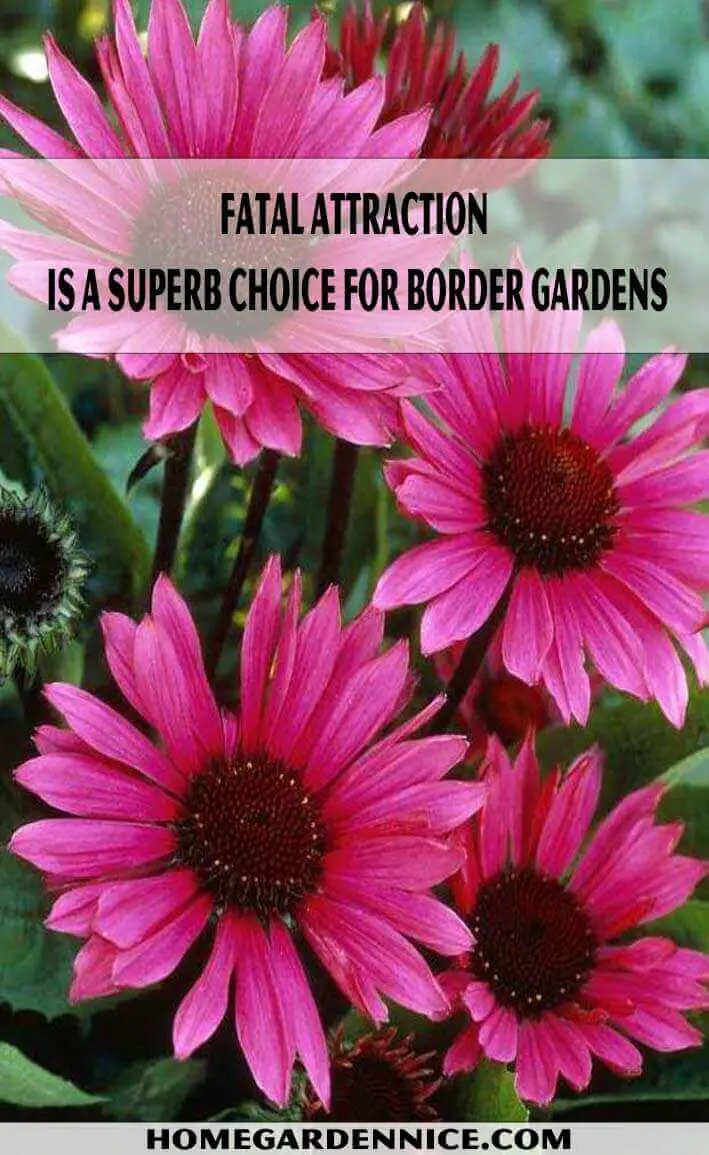
The daisy belongs to the family Asteraceae, which contains more than 23,000 species and 111 genera. The daisy belongs to the same family as chrysanthemums, sunflowers, and lettuce. The flower has a star-shaped head with many tiny petals that are surrounded by rays of longer petals. The Asteraceae family is also a member of the Compositae family, which contains many other popular flower species.
Echinacea ‘Fatal Attraction’ is a rare selection of the plant. This variety has long, dense stems that can reach 26″ in height and is covered in deep pink flowers. It is a favorite among hummingbirds and begins flowering in late June. It’s an excellent choice for any garden! Its long, dainty stems are attractive to butterflies and hummingbirds.
Subfamily: Mutisioideae
The subfamily Mutisioideae is a group of Asteraceae that includes 630 species across 44 genera. They are native to South America, but also include species in every continent except Antarctica. There are no extant species in Australia, but many of the members of this family are common in the wild. This article provides some information about the subfamily and its members. We’ll also cover some of its most well-known species.
The subfamily is named for its distinctive corolla, which helps separate it from related subfamilies. While other Cichorioideae species have bilabiate-like corollas, the Corolla of the Mutisioideae is tubular and dilates abruptly into a funnelform shape. Wunderlichia and Nouelia have funnelform corollas. The most closely related subfamily, Barnadesioideae, is named for its funnelform corolla.
The authors describe all of the genera in this subfamily and provide key characteristics to distinguish them. They refrain from prematurely creating taxonomic units within these tribes. There are no formal subtribes, but several lineages have received taxonomic status as a result of molecular studies. The authors also describe morphological and palynological characters of taxonomic value within Mutisioideae.
Tribe: Mutisieae
The daisy family is made up of three major tribes: the Mutisioideae, the Erythronium and the Gerbera-Complex. Together, they consist of about 200 species. However, their precise evolutionary relationships are still controversial. In recent years, a growing body of evidence suggests that the Mutisieae should be regarded as a separate family.
The pollen of the Mutisioideae belongs to the subfamily Mutisioideae, along with the Nassauvieae and Eriachaenium. The Mutisioideae’s pollen grains are large and elliptic, unlike those of their ancestors in the Anthemideae. Pollen grains of the two genera are unique; Pappus is only found in the Anthemideae.
The Barberton daisy belongs to the Barberton family. This species is native to southern Africa and contributes to the annual flower displays in Namaqualand. The flowers are distinctive for their salmon and orange ray florets. It grows up to 400 mm in height and pioneers disturbed soils. Despite its distinctive appearance, it is a common weed in the wild, making for an attractive and versatile garden plant.
Type Of Daisies Under The Genus Gerbera
Gerbera daisies are perennial, tufted, or caulescent herbs that grow in moist soil. They have long, pointed petals tinged with raspberry-pink. Despite their short stems and compact growth habit, they still make an impressive focal point in the garden. To grow your own, simply follow the directions on the package and you’ll be amazed at how easily these flowers thrive.
43. Woman Daisy
If you’re wondering what type of woman you are, then you’ve come to the right place. Daisy is a fascinating flower with plenty of variety. It is a low-maintenance flower that blooms from early summer into late summer and beyond. The flower’s center disc is edible and contains high amounts of Vitamin C. There are many uses for daisies as well. Among these uses are as an accent plant, for a garden, as an accent on a vase, or even as a flower to place inside a vase.
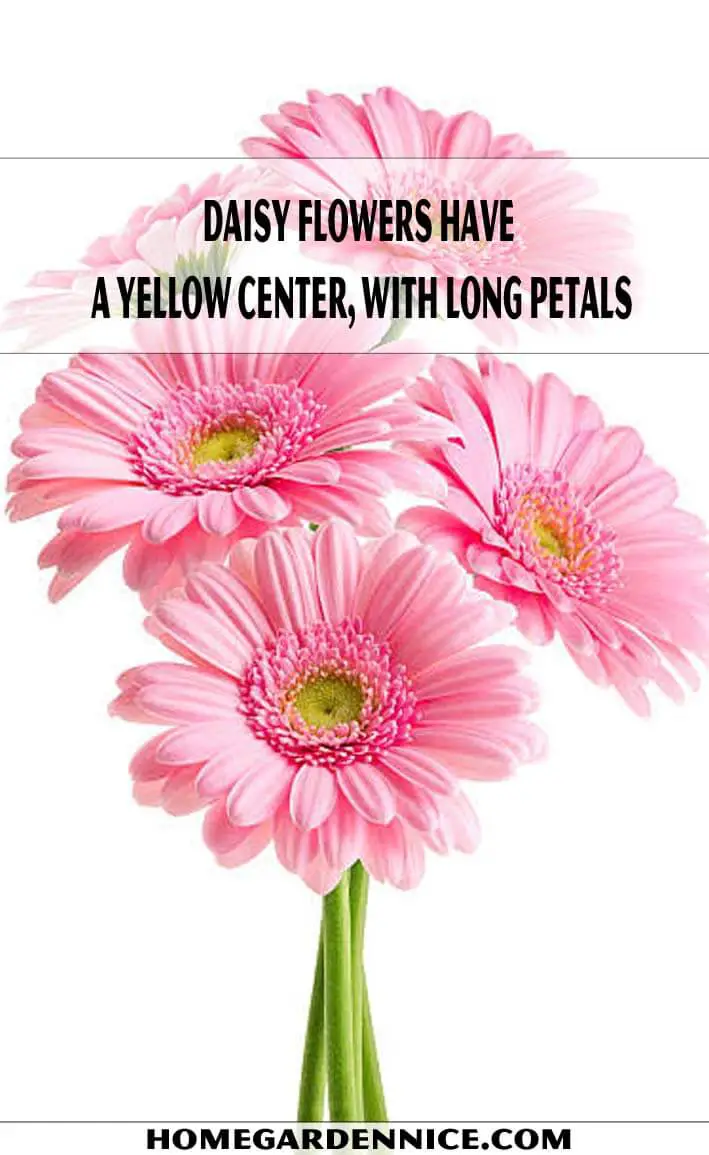
Daisy flowers have a yellow center, with long petals. They are often referred to as ‘daisies’ by florists. Today, there are several types of daisy flowers, from the exotic “Crazy” Shasta daisy to the colorful Gerber Daisy. The daisy family has a variety of colors and shapes. Women who like daisies will be pleasantly surprised.
44. Royal Yellow Daisy
Royal Yellow Types Of Daisies are one of the brightest types of daisies flowers, and they can be grown indoors in pots. They grow up to 5” across and like full sun. Royal Yellow Types Of Daisies do not tolerate moist soil, and they can become vulnerable to crown rot. They need adequate light to grow well, but do not overwater them. A few of these plants are tolerant of dry soil and will bloom indoors in pots.

The royal yellow type of daisy can be used to grow a formal or informal garden. Its flowers are one to three feet tall and will grow well in USDA zones nine to eleven. They prefer moist soil with a neutral or slightly acidic pH. Once the petals have fully dried, they can be harvested for their seeds. They can tolerate temperatures from 0 to 30°F. Their yellow disk is easily recognizable.
Among the Asteraceae family, Royal Yellow Gerbera Daisy has bold, bright yellow daisy flowers with brown eyes. It blooms early to mid-fall and makes excellent cutting flowers. The plant may also be called as its also known as black-eyed Susan. It has crinkled oval leaves that are grayish green in the underside. Unlike other daisies, it grows upright and spreads out.
45. Kir Red Daisy
The Transvaal daisy is a native to South Africa’s Mpumulanga province. Its long stalks are covered with flowers that are red, orange, or white. Though it is a perennial, it has a bad reputation in North America. It is best to plant in full sun and a well-drained soil. It can also be grown as a one year flower. Here is some information about the type of daisy.
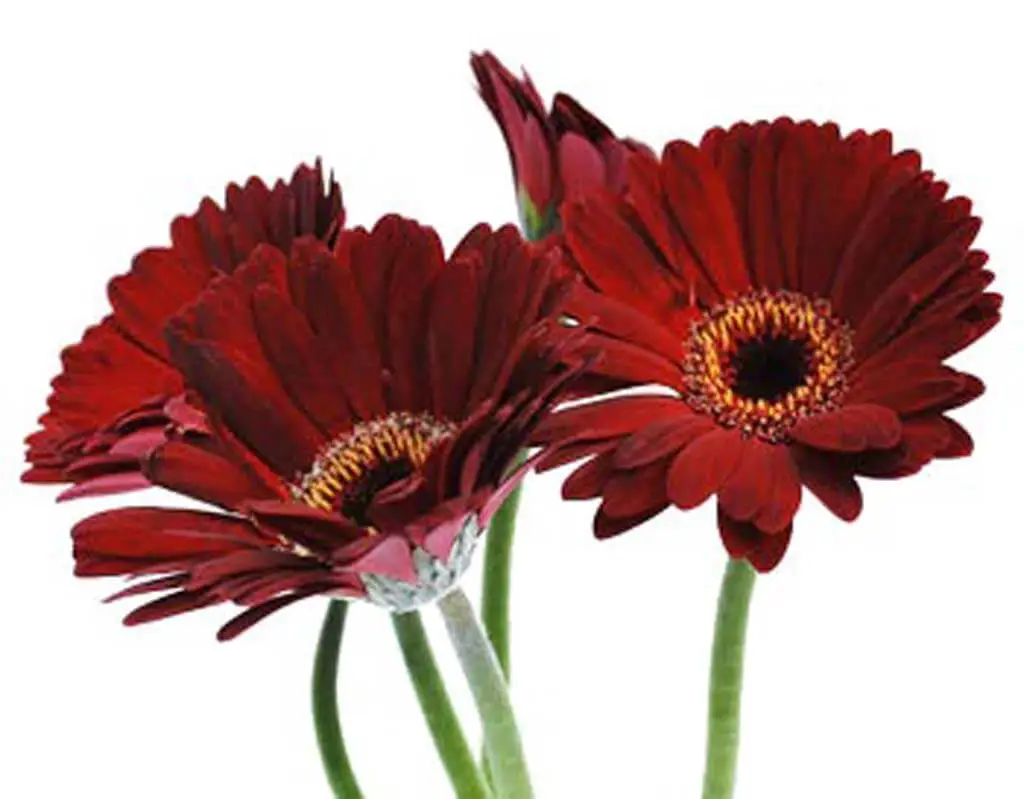
The Kir Red variety is very popular as a cut flower. These types of daisies variety are very versatile, and holds up well even after being cut. Its large flowers and trailing habit make it a great cut-flower for bouquets. It is considered a weed-free perennial, and grows best in full sunlight and average soil. It needs a moist climate, with good drainage. You can plant regular African daisies in your garden as annuals.
46. Gerbera Viridifolia
There are many benefits to growing the ‘Spider Daisies’ – or Gerberas – and this one is no exception. This species produces spiky, disk-shaped flowers with overlapping petals and is often called a spider daisy. It thrives in moist soil and will bloom best in full sun. There are also a variety of color combinations for you to choose from!
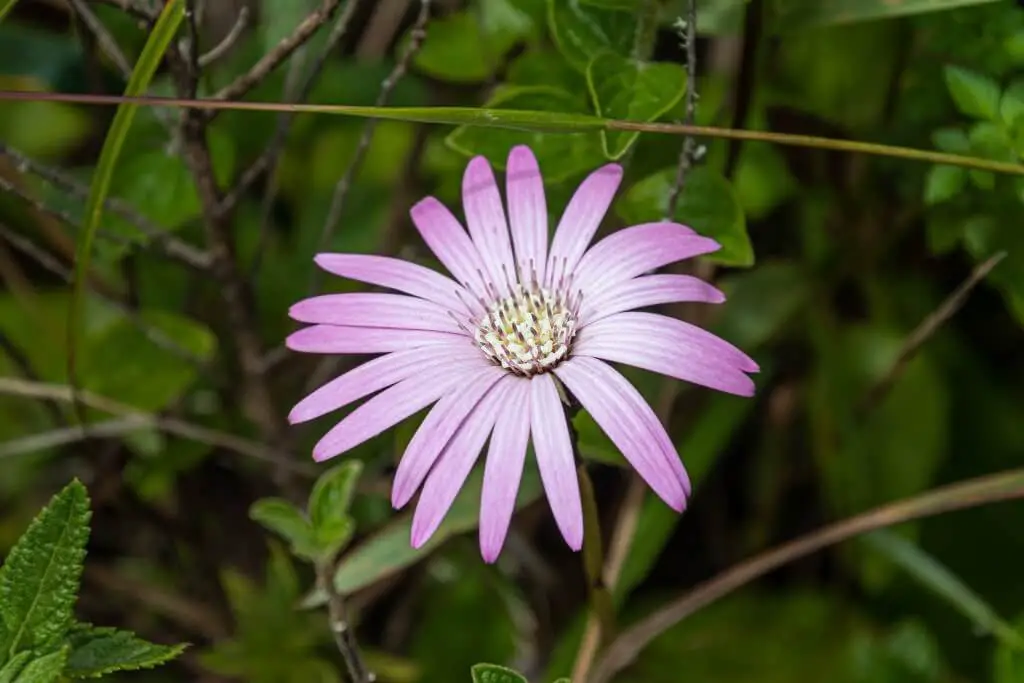
This tall perennial has white petals with violet or blue flower rays. It is a hardy plant that can survive temperatures of -10F. The stems and leaves are thick and woody, and it has a spiky appearance. It is a popular choice in garden beds because it is incredibly low maintenance and has flowers that bloom for weeks. Unlike many other flowers, the Painted Daisy is very resistant to pests and diseases.
A variety of varieties of gerbera daisies are available. The gerbera daisy is a favorite choice for cut flowers, centerpieces, and gardens. The Gerbera daisy comes in a wide range of colors, from white and pink to red, and they are often grown as an annual in garden beds. There are several types of Gerbera daisies and you should choose one according to your tastes and budget.
47. Dark Eye Daisy
The dark-eyed daisy, also known as the golden marguerite daisy, is an excellent choice for a perennial garden. Its golden-yellow flowers contrast beautifully with its deep green stems and leaves. Its foliage also emits a pleasant herbal scent. Despite its name, this daisy can be grown in a wide range of soil types, including alkaline, acidic, and neutral.
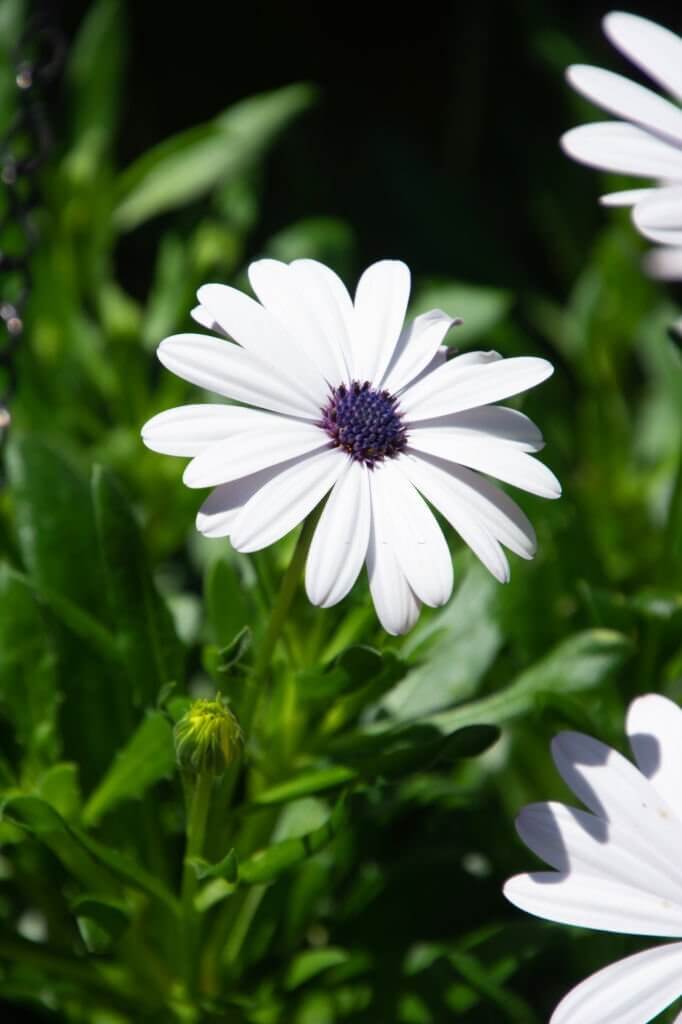
These types of daisies blooms at late spring. The petals are long and distanced, and start off white and gradually become darker. This type of daisy is ideal for gardens that have a wild, organic feel. The flower is hardy to USDA zones three through eight. It is also tolerant of clay soil and rocky soil. Unlike many other types of daisies, this one tolerates deer, drought, and clay soil.
We will continue to update other chrysanthemum species in part 2, please watch at https://homegardennice.com/ thanks
Conclusion
Desert daisies are native to the southwest United States. These types of daisies are common xeriscape plants, because they can grow in dry, wide-open areas. Desert daisies bloom all winter long and are often called desert daisies. They have hairy leaves and small stems. Their yellow and white flowers are surrounded by bright green foliage. These types of daisies grow well in dry, sandy soils, and high-humidity climates.

